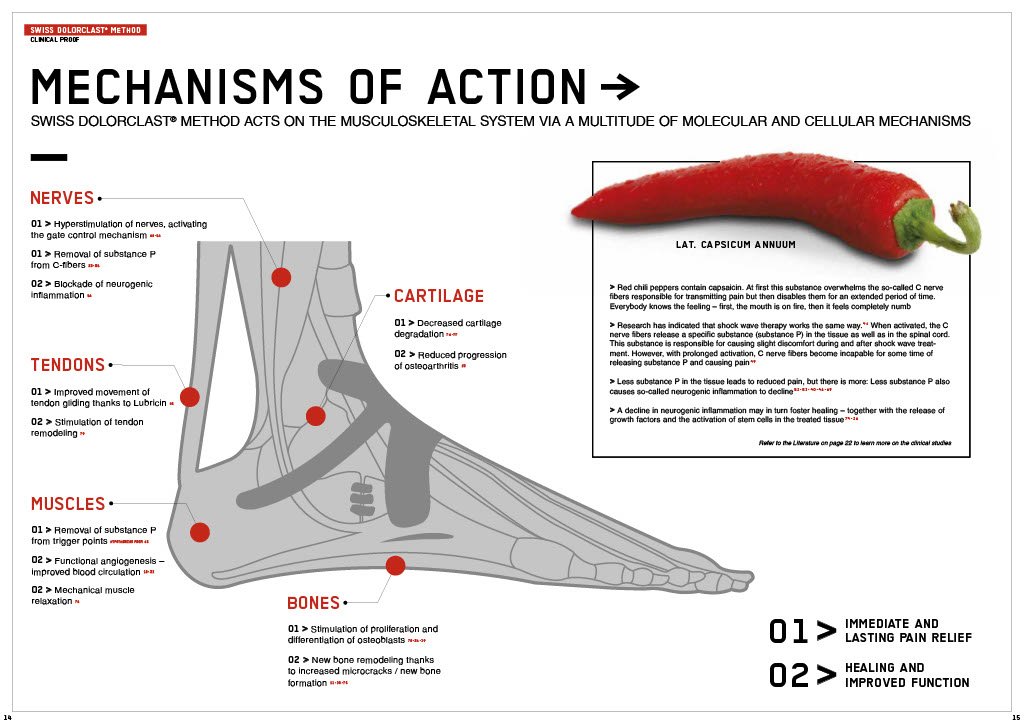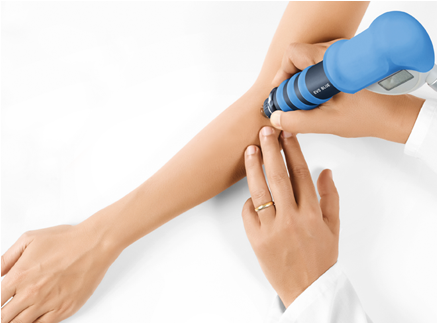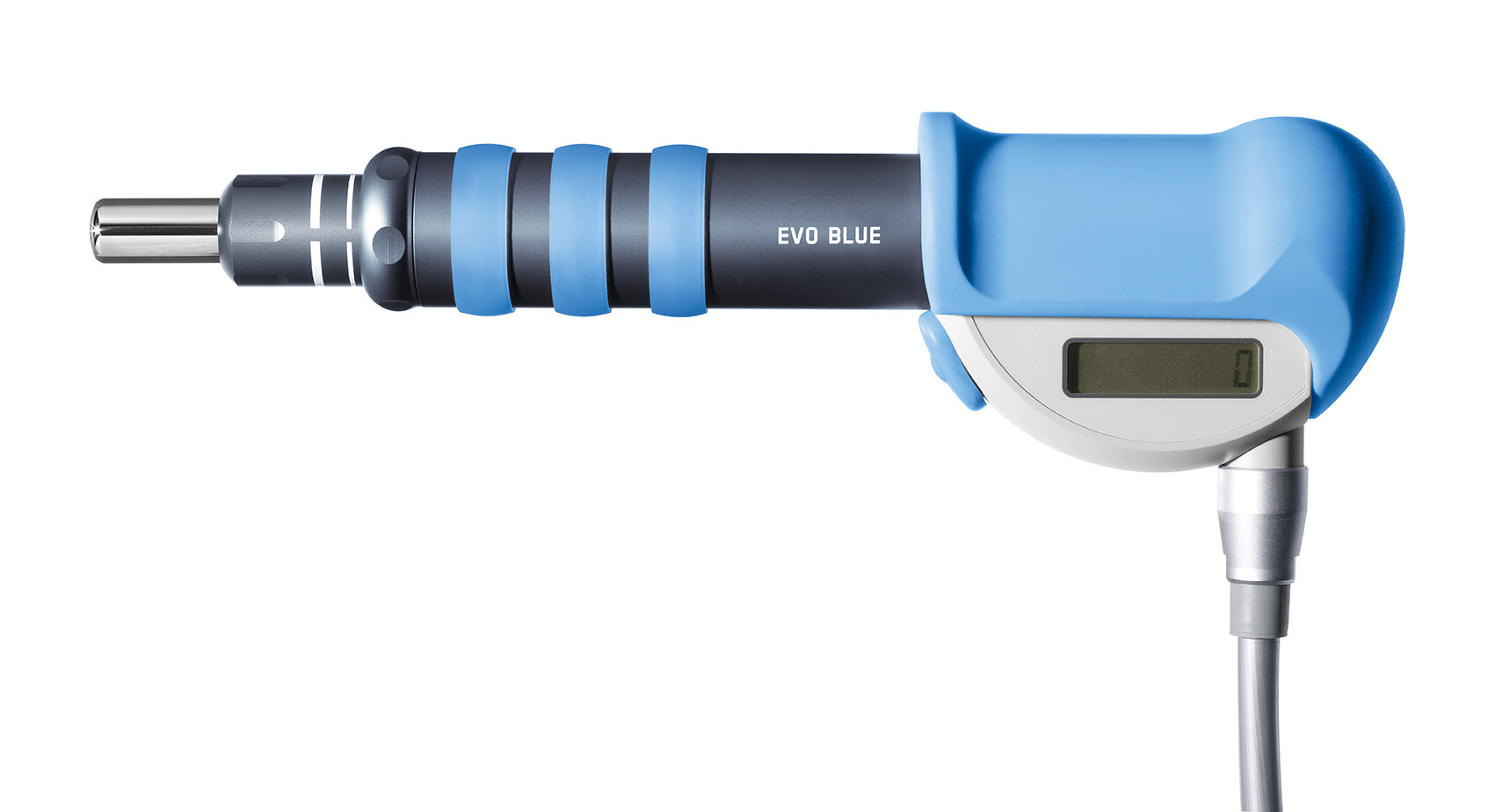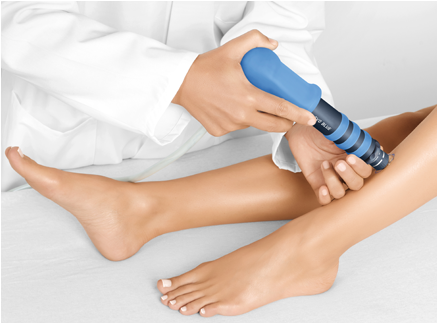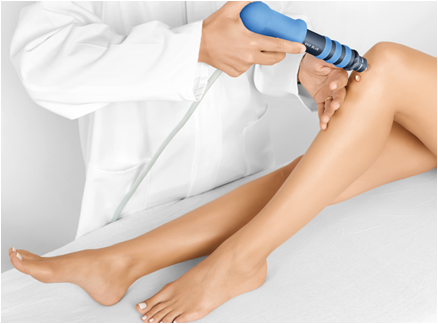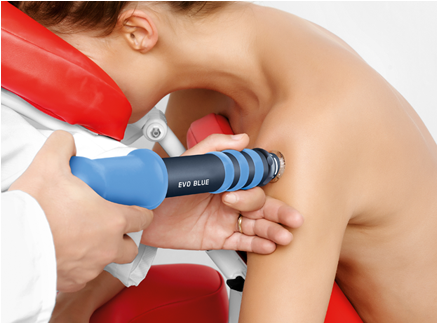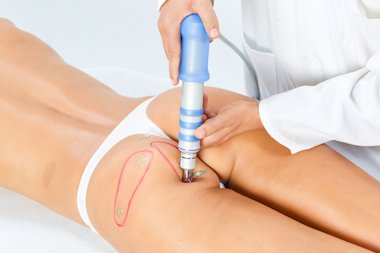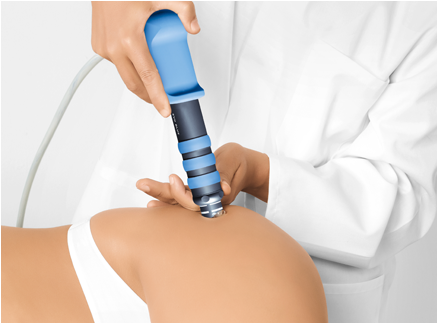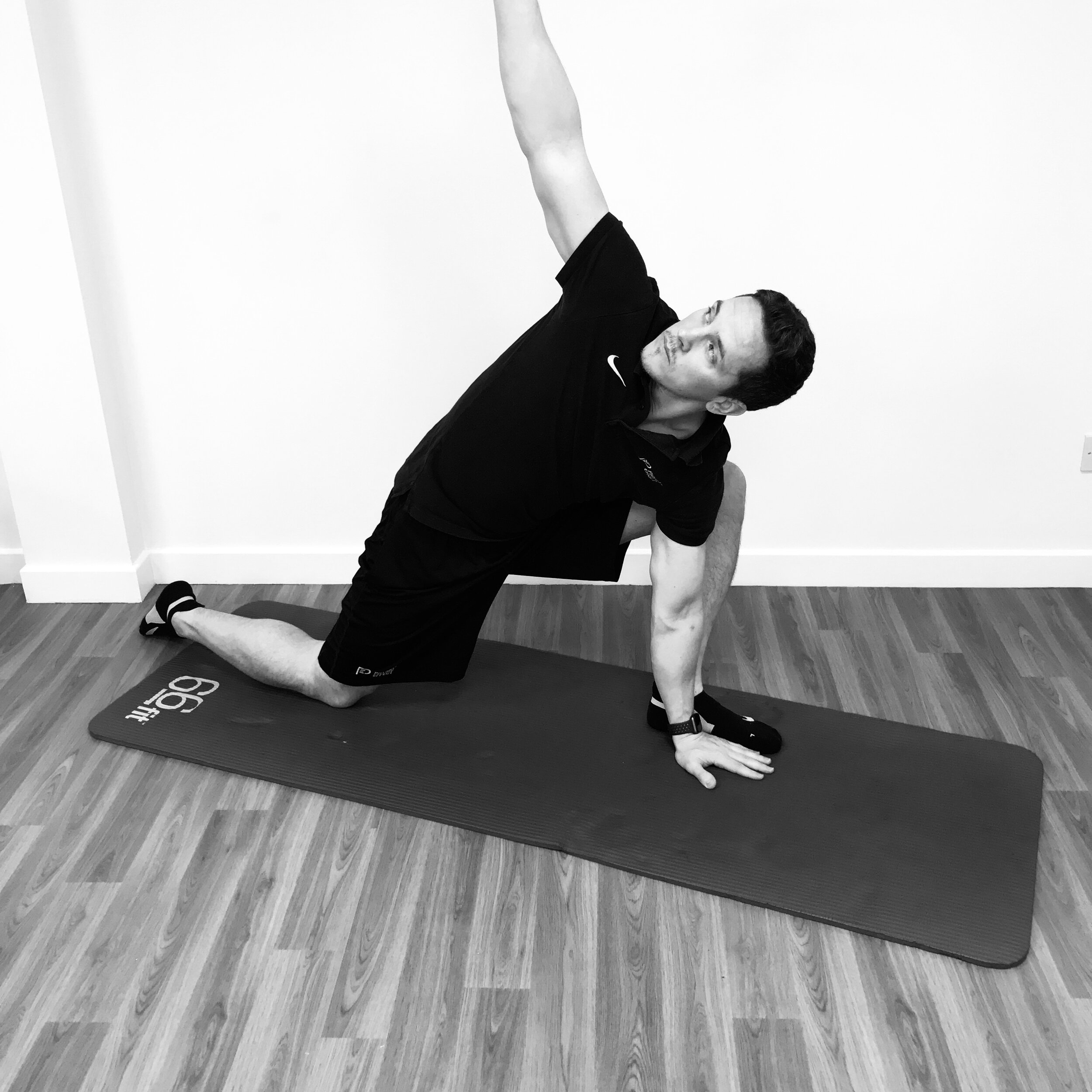Shockwave therapy for Tibial Stress syndrome (shin splints)
Written by Daniel Wray (BSc Hons Physio/ PG Dip Sports Physio)
What is Shockwave Therapy?
Shockwave therapy is a non invasive, non surgical procedure used to treat a variety of injuries and painful conditions. It is often referred to as extracorporeal (outside of the body) shockwave therapy or ESWT.
Shockwave therapy for tibial stress syndrome (shin splints)
Shockwaves are a type of acoustic wave which carry high energy to painful areas and tissues during various phases of injury helping to stimulate a tissue healing response.
The waves are created by compressed air which is then applied by the therapist onto the affected area via a handheld device.
Shockwave has recently been compared to ultrasound, however the two waveforms are very different. The energy produced via shockwave promotes regeneration and reparative processes of the bones, tendons and other soft tissues.
Shockwave therapy carries minimal risk and is a fast and effective treatment for many chronic painful conditions. The picture below descibres some of the mechanisms of action for shockwave therapy.
WHAT IS TIBIAL STRESS SYNDROME?
Tibial stress syndrome, also known as shin splints, is an overuse injury which leads to persistent dull pain at the front of the shin along the tibial edge.
It is more common in those who don’t exercise regularly and then suddenly try to run or increase activity levels significantly.
Symptoms include overall pain at the shin area, pain after exercise and if severe, can be painful when walking or using stairs
SHOCKWAVE THERAPY FOR TIBIAL STRESS SYNDROME
Clients who do not respond to conservative treatment including reduced activity and stretching and strengthening exercises should consider shockwave therapy.
Shockwave therapy can be targeted at the painful area and can increase blood flow as well as stem cell activity promoting increased healing and reduced pain
For optimal treatment outcomes shockwave therapy will be combined with a bespoke rehabilitation and strengthening plan based around an assessment of your unique needs and goals by our experienced Physiotherapists
Shockwave therapy for tibial stress syndrome (shin splints)
What does a shockwave treatment session involve?
Shockwave therapy for tennis elbow (Lateral epicondylalgia)
Shockwave therapy requires no injections or surgery.
It is usually indicated when Physiotherapy alone does not improve specific symptoms which have persisted for at least 12 weeks.
The treatment is administered via a handheld device which is placed on the skin above the injured area. The shockwaves pass into the tissue in the form of low energy sound waves which pass into the injured area enhancing blood flow and stimulating a tissue healing response.
For optimal results shockwave treatment requires a course of 3-4 treatments delivered once every 7-10 days. The shockwave treatment itself takes only a few minutes. When you book Shockwave therapy at Physio Effect we will always assess you fully on an individual basis, listening carefully to your history and needs, so that we can formulate the best possible treatment plan.
Why choose the Swiss Dolorclast?
Swiss Dolorclast Smart 20 shockwave System
Not all shockwave treatments are equal so please be careful and research before committing to any treatment. Some companies may charge significant amounts for shockwave therapy yet deliver their treatment on cheap, untested and sub-standard machines. Cheap machines will be unable to produce the kind of pressures required to create a therapeutic treatment effect. At Physio Effect we do not compromise on quality and have therefore purchased the top of the range Swiss Dolorclast system to deliver our shockwave treatments.
Evo Blue Handheld Probe
The Swiss Dolorclast systems have been tried, tested and proven as effective systems for pain relief and injury recovery. On the Physiotherapy evidence Database 34 out of 62 randomised controlled trials listed used the Dolorclast shockwave systems, providing substantial high quality evidence of their efficacy.
Does shockwave therapy hurt?
Shockwave treatment for medial tibial stress syndrome (shin splints)
In simple terms shockwave treatment is at the least uncomfortable and in some cases can be painful. The nature of this technology requires the delivered shockwaves to create a focal tissue response to stimulate blood flow and cell reaction and to achieve this a level of discomfort is required. If you have received pain free shockwave treatment or been offered it as pain free it may be worth questioning if the intensity and quality of treatment provided is within the range required for therapeutic benefit.
Shockwave treatment generally takes only 3-5 minutes to deliver so most people are quite able to cope with the short duration of discomfort. Your therapist will work with you to adjust the treatment intensity so that optimal results can be achieved while managing any discomfort.
Is there any reason I can’t have shockwave therapy?
In general terms shockwave therapy is very safe and causes minimal side effects. There are relatively few contraindications to the radial shockwave which we use here at Physio Effect.
Shockwave therapy is contraindicated if;
You are pregnant
You are being treated for cancer
You have an infection or wound at the treatment site
You have had a steroid injection in the previous 6 weeks
Shockwave therapy for subacromial impingement syndrome
Shockwave therapy may not be appropriate, or used with caution if;
You have metal pins, plates or prosthesis in the area requiring treatment
You have a blood clotting disorder
You are under 18
You are taking anticoagulant medication
You have had a serious tissue rupture at the injury site previously
Loss of sensation at the site of injury
If you are in any doubt about whether shockwave therapy is suitable for you then please contact us and we will be happy to guide you.
Seeking guidance or have questions? We Can Help.
Our experienced team at Physio Effect are specialists in the field and will be happy to answer any questions you might have about Shockwave Therapy. Click below to contact us.
Ready to take decisive action and book shockwave therapy? Click below to Book Now!
Thank You
Thank you for taking the time to read this post, we sincerely hope that you find it useful. We appreciate all feedback so please take a moment and let us know what you think.
Shockwave therapy for Osgood Schlatter disease
Written by Daniel Wray (BSc Hons Physio/ PG Dip Sports Physio)
What is Shockwave Therapy?
Shockwave therapy is a non invasive, non surgical procedure used to treat a variety of injuries and painful conditions. It is often referred to as extracorporeal (outside of the body) shockwave therapy or ESWT.
Shockwave therapy for Osgood Schlatter disease
Shockwaves are a type of acoustic wave which carry high energy to painful areas and tissues during various phases of injury helping to stimulate a tissue healing response.
The waves are created by compressed air which is then applied by the therapist onto the affected area via a handheld device.
Shockwave has recently been compared to ultrasound, however the two waveforms are very different. The energy produced via shockwave promotes regeneration and reparative processes of the bones, tendons and other soft tissues.
Shockwave therapy carries minimal risk and is a fast and effective treatment for many chronic painful conditions. The picture below descibres some of the mechanisms of action for shockwave therapy.
WHAT IS OSGOOD SCHLATTER DISEASE?
Osgood-Schlatter is inflammation inflammation of the area just below the knee where the tendon from the kneecap (patellar tendon) attaches to the shinbone (tibia) at the tibial tuberosity.
It is most common during growth spurts in adolescents when bones, tendons, muscles and other structures are changing rapidly. Physical activity puts further stress on these structures so adolescents who participate in sports such as running, football, and athletics are more susceptible to this injury
Symptoms include knee pain, pain at the top of the shin and tight quads and hamstrings
SHOCKWAVE THERAPY FOR OSGOOD SCHLATTER DISEASE
Clients who do not respond to conservative treatment including activity modification and stretching and strengthening exercises should consider shockwave therapy.
The shock waves applied promote blood flow and stimulate stem cell activity in the tissue providing pain relief while increasing the healing response.
For optimal treatment outcomes shockwave therapy will be combined with a bespoke rehabilitation and strengthening plan based around an assessment of your unique needs and goals by our experienced Physiotherapists
Shockwave therapy for Osgood Schlatter disease
What does a shockwave treatment session involve?
Shockwave therapy for tennis elbow (Lateral epicondylalgia)
Shockwave therapy requires no injections or surgery.
It is usually indicated when Physiotherapy alone does not improve specific symptoms which have persisted for at least 12 weeks.
The treatment is administered via a handheld device which is placed on the skin above the injured area. The shockwaves pass into the tissue in the form of low energy sound waves which pass into the injured area enhancing blood flow and stimulating a tissue healing response.
For optimal results shockwave treatment requires a course of 3-4 treatments delivered once every 7-10 days. The shockwave treatment itself takes only a few minutes. When you book Shockwave therapy at Physio Effect we will always assess you fully on an individual basis, listening carefully to your history and needs, so that we can formulate the best possible treatment plan.
Why choose the Swiss Dolorclast?
Swiss Dolorclast Smart 20 shockwave System
Not all shockwave treatments are equal so please be careful and research before committing to any treatment. Some companies may charge significant amounts for shockwave therapy yet deliver their treatment on cheap, untested and sub-standard machines. Cheap machines will be unable to produce the kind of pressures required to create a therapeutic treatment effect. At Physio Effect we do not compromise on quality and have therefore purchased the top of the range Swiss Dolorclast system to deliver our shockwave treatments.
Evo Blue Handheld Probe
The Swiss Dolorclast systems have been tried, tested and proven as effective systems for pain relief and injury recovery. On the Physiotherapy evidence Database 34 out of 62 randomised controlled trials listed used the Dolorclast shockwave systems, providing substantial high quality evidence of their efficacy.
Does shockwave therapy hurt?
Shockwave treatment for medial tibial stress syndrome (shin splints)
In simple terms shockwave treatment is at the least uncomfortable and in some cases can be painful. The nature of this technology requires the delivered shockwaves to create a focal tissue response to stimulate blood flow and cell reaction and to achieve this a level of discomfort is required. If you have received pain free shockwave treatment or been offered it as pain free it may be worth questioning if the intensity and quality of treatment provided is within the range required for therapeutic benefit.
Shockwave treatment generally takes only 3-5 minutes to deliver so most people are quite able to cope with the short duration of discomfort. Your therapist will work with you to adjust the treatment intensity so that optimal results can be achieved while managing any discomfort.
Is there any reason I can’t have shockwave therapy?
In general terms shockwave therapy is very safe and causes minimal side effects. There are relatively few contraindications to the radial shockwave which we use here at Physio Effect.
Shockwave therapy is contraindicated if;
You are pregnant
You are being treated for cancer
You have an infection or wound at the treatment site
You have had a steroid injection in the previous 6 weeks
Shockwave therapy for subacromial impingement syndrome
Shockwave therapy may not be appropriate, or used with caution if;
You have metal pins, plates or prosthesis in the area requiring treatment
You have a blood clotting disorder
You are under 18 (parent / guardian consent required)
You are taking anticoagulant medication
You have had a serious tissue rupture at the injury site previously
Loss of sensation at the site of injury
If you are in any doubt about whether shockwave therapy is suitable for you then please contact us and we will be happy to guide you.
Seeking guidance or have questions? We Can Help.
Our experienced team at Physio Effect are specialists in the field and will be happy to answer any questions you might have about Shockwave Therapy. Click below to contact us.
Ready to take decisive action and book shockwave therapy? Click below to Book Now!
Thank You
Thank you for taking the time to read this post, we sincerely hope that you find it useful. We appreciate all feedback so please take a moment and let us know what you think.
Shockwave therapy for shoulder impingement syndrome
Written by Daniel Wray (BSc Hons Physio/ PG Dip Sports Physio)
What is Shockwave Therapy?
Shockwave therapy is a non invasive, non surgical procedure used to treat a variety of injuries and painful conditions. It is often referred to as extracorporeal (outside of the body) shockwave therapy or ESWT.
Shockwave therapy for shoulder impingement syndrome
Shockwaves are a type of acoustic wave which carry high energy to painful areas and tissues during various phases of injury helping to stimulate a tissue healing response.
The waves are created by compressed air which is then applied by the therapist onto the affected area via a handheld device.
Shockwave has recently been compared to ultrasound, however the two waveforms are very different. The energy produced via shockwave promotes regeneration and reparative processes of the bones, tendons and other soft tissues.
Shockwave therapy carries minimal risk and is a fast and effective treatment for many chronic painful conditions. The picture below descibres some of the mechanisms of action for shockwave therapy.
WHAT IS SHOULDER IMPINGEMENT SYNDROME?
Shoulder impingement is often referred to as swimmers shoulder due to the repeated overhead motions carried out by swimmers. It may also be known as subacromial impingement.
Impingement is when the supraspinatus tendon of the rotator cuff rubs against the acromion (shoulder blade) due to a narrowing of the space between these two structures. The tendon can be repeatedly pinched or impinged leading to tissue injury, inflammation and pain.
Symptoms include sudden catching pain when lifting your arm overhead or backwards. Pain can occur at night causing sleep disturbance
Impingement can occur after a fall onto an outstretched arm but is more typically a gradual process caused by wear and tear and overuse of the shoulder
Impingement is more common in sports requiring repetitive overhead shoulder movements such as tennis or swimming
SHOCKWAVE THERAPY FOR SHOULDER IMPINGEMENT
Shock waves are passed through the skin to the injured part of the shoulder using a special hand held probe.
The shock waves applied promote blood flow and stimulate stem cell activity in the tissue providing pain relief while increasing the healing response.
For optimal treatment outcomes shockwave therapy will be combined with a bespoke rehabilitation and strengthening plan based around an assessment of your unique needs and goals by our experienced Physiotherapists
Shockwave therapy for shoulder impingement syndrome
What does a shockwave treatment session involve?
Shockwave therapy for tennis elbow (Lateral epicondylalgia)
Shockwave therapy requires no injections or surgery.
It is usually indicated when Physiotherapy alone does not improve specific symptoms which have persisted for at least 12 weeks.
The treatment is administered via a handheld device which is placed on the skin above the injured area. The shockwaves pass into the tissue in the form of low energy sound waves which pass into the injured area enhancing blood flow and stimulating a tissue healing response.
For optimal results shockwave treatment requires a course of 3-4 treatments delivered once every 7-10 days. The shockwave treatment itself takes only a few minutes. When you book Shockwave therapy at Physio Effect we will always assess you fully on an individual basis, listening carefully to your history and needs, so that we can formulate the best possible treatment plan.
Why choose the Swiss Dolorclast?
Swiss Dolorclast Smart 20 shockwave System
Not all shockwave treatments are equal so please be careful and research before committing to any treatment. Some companies may charge significant amounts for shockwave therapy yet deliver their treatment on cheap, untested and sub-standard machines. Cheap machines will be unable to produce the kind of pressures required to create a therapeutic treatment effect. At Physio Effect we do not compromise on quality and have therefore purchased the top of the range Swiss Dolorclast system to deliver our shockwave treatments.
Evo Blue Handheld Probe
The Swiss Dolorclast systems have been tried, tested and proven as effective systems for pain relief and injury recovery. On the Physiotherapy evidence Database 34 out of 62 randomised controlled trials listed used the Dolorclast shockwave systems, providing substantial high quality evidence of their efficacy.
Does shockwave therapy hurt?
Shockwave treatment for medial tibial stress syndrome (shin splints)
In simple terms shockwave treatment is at the least uncomfortable and in some cases can be painful. The nature of this technology requires the delivered shockwaves to create a focal tissue response to stimulate blood flow and cell reaction and to achieve this a level of discomfort is required. If you have received pain free shockwave treatment or been offered it as pain free it may be worth questioning if the intensity and quality of treatment provided is within the range required for therapeutic benefit.
Shockwave treatment generally takes only 3-5 minutes to deliver so most people are quite able to cope with the short duration of discomfort. Your therapist will work with you to adjust the treatment intensity so that optimal results can be achieved while managing any discomfort.
Is there any reason I can’t have shockwave therapy?
In general terms shockwave therapy is very safe and causes minimal side effects. There are relatively few contraindications to the radial shockwave which we use here at Physio Effect.
Shockwave therapy is contraindicated if;
You are pregnant
You are being treated for cancer
You have an infection or wound at the treatment site
You have had a steroid injection in the previous 6 weeks
Shockwave therapy for subacromial impingement syndrome
Shockwave therapy may not be appropriate, or used with caution if;
You have metal pins, plates or prosthesis in the area requiring treatment
You have a blood clotting disorder
You are under 18
You are taking anticoagulant medication
You have had a serious tissue rupture at the injury site previously
Loss of sensation at the site of injury
If you are in any doubt about whether shockwave therapy is suitable for you then please contact us and we will be happy to guide you.
Seeking guidance or have questions? We Can Help.
Our experienced team at Physio Effect are specialists in the field and will be happy to answer any questions you might have about Shockwave Therapy. Click below to contact us.
Ready to take decisive action and book shockwave therapy? Click below to Book Now!
Thank You
Thank you for taking the time to read this post, we sincerely hope that you find it useful. We appreciate all feedback so please take a moment and let us know what you think.
Shockwave therapy for proximal hamstring tendinopathy
Written by Daniel Wray (BSc Hons Physio/ PG Dip Sports Physio)
What is Shockwave Therapy?
Shockwave therapy is a non invasive, non surgical procedure used to treat a variety of injuries and painful conditions. It is often referred to as extracorporeal (outside of the body) shockwave therapy or ESWT.
Shockwave therapy for proximal hamstring tendinopathy
Shockwaves are a type of acoustic wave which carry high energy to painful areas and tissues during various phases of injury helping to stimulate a tissue healing response.
The waves are created by compressed air which is then applied by the therapist onto the affected area via a handheld device.
Shockwave has recently been compared to ultrasound, however the two waveforms are very different. The energy produced via shockwave promotes regeneration and reparative processes of the bones, tendons and other soft tissues.
Shockwave therapy carries minimal risk and is a fast and effective treatment for many chronic painful conditions. The picture below descibres some of the mechanisms of action for shockwave therapy.
WHAT IS PROXIMAL HAMSTRING TENDINOPATHY?
Proximal hamstring tendinopathy is the breakdown of collagen at the top of the hamstrings near to where the tendon attaches to the bone. It is common among long distance runners and athletes that regularly sprint with directional changes
Symptoms include pain at the very top of the hamstrings, just at the buttock crease. Pain usually occurs after activities with increased post exercise stiffness
The condition is typically the result of cumulative micro-trauma to the tendon which fails to fully heal. This results in degeneration and partial tearing of the tendon causing pain, weakness and impaired function
Symptoms may be progressive over many months or even years
SHOCKWAVE THERAPY FOR PROXIMAL HAMSTRING TENDINOPATHY
Shock waves are passed through the skin to the injured part of the hamstring using a special hand held probe.
The shock waves applied promote blood flow and stimulate stem cell activity in the tissue providing pain relief while increasing the healing response.
For optimal treatment outcomes shockwave therapy will be combined with a bespoke rehabilitation and strengthening plan based around an assessment of your unique needs and goals by our experienced Physiotherapists
Shockwave therapy for proximal hamstring tendinopathy
What does a shockwave treatment session involve?
Shockwave therapy for tennis elbow (Lateral epicondylalgia)
Shockwave therapy requires no injections or surgery.
It is usually indicated when Physiotherapy alone does not improve specific symptoms which have persisted for at least 12 weeks.
The treatment is administered via a handheld device which is placed on the skin above the injured area. The shockwaves pass into the tissue in the form of low energy sound waves which pass into the injured area enhancing blood flow and stimulating a tissue healing response.
For optimal results shockwave treatment requires a course of 3-4 treatments delivered once every 7-10 days. The shockwave treatment itself takes only a few minutes. When you book Shockwave therapy at Physio Effect we will always assess you fully on an individual basis, listening carefully to your history and needs, so that we can formulate the best possible treatment plan.
Why choose the Swiss Dolorclast?
Swiss Dolorclast Smart 20 shockwave System
Not all shockwave treatments are equal so please be careful and research before committing to any treatment. Some companies may charge significant amounts for shockwave therapy yet deliver their treatment on cheap, untested and sub-standard machines. Cheap machines will be unable to produce the kind of pressures required to create a therapeutic treatment effect. At Physio Effect we do not compromise on quality and have therefore purchased the top of the range Swiss Dolorclast system to deliver our shockwave treatments.
Evo Blue Handheld Probe
The Swiss Dolorclast systems have been tried, tested and proven as effective systems for pain relief and injury recovery. On the Physiotherapy evidence Database 34 out of 62 randomised controlled trials listed used the Dolorclast shockwave systems, providing substantial high quality evidence of their efficacy.
Does shockwave therapy hurt?
Shockwave treatment for medial tibial stress syndrome (shin splints)
In simple terms shockwave treatment is at the least uncomfortable and in some cases can be painful. The nature of this technology requires the delivered shockwaves to create a focal tissue response to stimulate blood flow and cell reaction and to achieve this a level of discomfort is required. If you have received pain free shockwave treatment or been offered it as pain free it may be worth questioning if the intensity and quality of treatment provided is within the range required for therapeutic benefit.
Shockwave treatment generally takes only 3-5 minutes to deliver so most people are quite able to cope with the short duration of discomfort. Your therapist will work with you to adjust the treatment intensity so that optimal results can be achieved while managing any discomfort.
Is there any reason I can’t have shockwave therapy?
In general terms shockwave therapy is very safe and causes minimal side effects. There are relatively few contraindications to the radial shockwave which we use here at Physio Effect.
Shockwave therapy is contraindicated if;
You are pregnant
You are being treated for cancer
You have an infection or wound at the treatment site
You have had a steroid injection in the previous 6 weeks
Shockwave therapy for subacromial impingement syndrome
Shockwave therapy may not be appropriate, or used with caution if;
You have metal pins, plates or prosthesis in the area requiring treatment
You have a blood clotting disorder
You are under 18
You are taking anticoagulant medication
You have had a serious tissue rupture at the injury site previously
Loss of sensation at the site of injury
If you are in any doubt about whether shockwave therapy is suitable for you then please contact us and we will be happy to guide you.
Seeking guidance or have questions? We Can Help.
Our experienced team at Physio Effect are specialists in the field and will be happy to answer any questions you might have about Shockwave Therapy. Click below to contact us.
Ready to take decisive action and book shockwave therapy? Click below to Book Now!
Thank You
Thank you for taking the time to read this post, we sincerely hope that you find it useful. We appreciate all feedback so please take a moment and let us know what you think.
Shockwave therapy for tennis elbow (lateral epicondylitis)
Written by Daniel Wray (BSc Hons Physio/ PG Dip Sports Physio)
What is Shockwave Therapy?
Shockwave therapy is a non invasive, non surgical procedure used to treat a variety of injuries and painful conditions. It is often referred to as extracorporeal (outside of the body) shockwave therapy or ESWT.
Shockwave therapy for tennis elbow (lateral epicondylitis)
Shockwaves are a type of acoustic wave which carry high energy to painful areas and tissues during various phases of injury helping to stimulate a tissue healing response.
The waves are created by compressed air which is then applied by the therapist onto the affected area via a handheld device.
Shockwave has recently been compared to ultrasound, however the two waveforms are very different. The energy produced via shockwave promotes regeneration and reparative processes of the bones, tendons and other soft tissues.
Shockwave therapy carries minimal risk and is a fast and effective treatment for many chronic painful conditions.
Physio Effect are so confident in their shockwave therapy we offer a ‘Money Back Guarantee’ (Ts & Cs Apply)
Want to learn more about our Expert Approach to treating Tennis Elbow? Click HERE
WHAT IS TENNIS ELBOW (LATERAL EPICONDYLITIS)?
Lateral Epicondylitis is commonly known as tennis elbow while Medial Epicondylitis is known as golfers elbow.
It is caused by overuse of the muscles of the forearm which attach to the inner (golfers) and outer (tennis) elbow
Overuse causes tissue overload and cumulative micro-trauma where damaged tissue fails to properly heal. Pain and weakness then occur at the outside (lateral) or inside (medial) of the elbow joint
Symptoms include pain when lifting or bending your arm. Weakness and pain often occur when gripping and lifting objects or when twisting your forearm such as opening a jar
Symptoms may be progressive over many months or even years
SHOCKWAVE THERAPY FOR TENNIS OR GOLFERS ELBOW
Shock waves are passed through the skin to the injured part of the elbow, using a special hand held probe.
The shock waves applied promote blood flow and stimulate stem cell activity in the tissue providing pain relief while increasing the healing response.
For optimal treatment outcomes shockwave therapy will be combined with a bespoke rehabilitation and strengthening plan based around an assessment of your unique needs and goals by our experienced Physiotherapists
Shockwave therapy for tennis elbow (lateral epicondylitis)
What does a shockwave treatment session involve?
Shockwave therapy for tennis elbow (Lateral epicondylalgia)
Shockwave therapy requires no injections or surgery.
It is usually indicated when Physiotherapy alone does not improve specific symptoms which have persisted for at least 12 weeks.
The treatment is administered via a handheld device which is placed on the skin above the injured area. The shockwaves pass into the tissue in the form of low energy sound waves which pass into the injured area enhancing blood flow and stimulating a tissue healing response.
For optimal results shockwave treatment requires a course of 3-4 treatments delivered once every 7-10 days. The shockwave treatment itself takes only a few minutes. When you book Shockwave therapy at Physio Effect we will always assess you fully on an individual basis, listening carefully to your history and needs, so that we can formulate the best possible treatment plan.
Why choose the Swiss Dolorclast?
Swiss Dolorclast Smart 20 shockwave System
Not all shockwave treatments are equal so please be careful and research before committing to any treatment. Some companies may charge significant amounts for shockwave therapy yet deliver their treatment on cheap, untested and sub-standard machines. Cheap machines will be unable to produce the kind of pressures required to create a therapeutic treatment effect. At Physio Effect we do not compromise on quality and have therefore purchased the top of the range Swiss Dolorclast system to deliver our shockwave treatments.
Evo Blue Handheld Probe
The Swiss Dolorclast systems have been tried, tested and proven as effective systems for pain relief and injury recovery. On the Physiotherapy evidence Database 34 out of 62 randomised controlled trials listed used the Dolorclast shockwave systems, providing substantial high quality evidence of their efficacy.
Does shockwave therapy hurt?
Shockwave treatment for medial tibial stress syndrome (shin splints)
In simple terms shockwave treatment is at the least uncomfortable and in some cases can be painful. The nature of this technology requires the delivered shockwaves to create a focal tissue response to stimulate blood flow and cell reaction and to achieve this a level of discomfort is required. If you have received pain free shockwave treatment or been offered it as pain free it may be worth questioning if the intensity and quality of treatment provided is within the range required for therapeutic benefit.
Shockwave treatment generally takes only 3-5 minutes to deliver so most people are quite able to cope with the short duration of discomfort. Your therapist will work with you to adjust the treatment intensity so that optimal results can be achieved while managing any discomfort.
Is there any reason I can’t have shockwave therapy?
In general terms shockwave therapy is very safe and causes minimal side effects. There are relatively few contraindications to the radial shockwave which we use here at Physio Effect.
Shockwave therapy is contraindicated if;
You are pregnant
You are being treated for cancer
You have an infection or wound at the treatment site
You have had a steroid injection in the previous 6 weeks
Shockwave therapy for subacromial impingement syndrome
Shockwave therapy may not be appropriate, or used with caution if;
You have metal pins, plates or prosthesis in the area requiring treatment
You have a blood clotting disorder
You are under 18
You are taking anticoagulant medication
You have had a serious tissue rupture at the injury site previously
Loss of sensation at the site of injury
If you are in any doubt about whether shockwave therapy is suitable for you then please contact us and we will be happy to guide you.
Seeking guidance or have questions? We Can Help.
Our experienced team at Physio Effect are specialists in the field and will be happy to answer any questions you might have about Shockwave Therapy. Click below to contact us.
Thank You
Thank you for taking the time to read this post, we sincerely hope that you find it useful. We appreciate all feedback so please take a moment and let us know what you think.
Shockwave therapy for calcific shoulder tendinopathy
Written by Daniel Wray (BSc Hons Physio/ PG Dip Sports Physio)
What is Shockwave Therapy?
Shockwave therapy is a non invasive, non surgical procedure used to treat a variety of injuries and painful conditions. It is often referred to as extracorporeal (outside of the body) shockwave therapy or ESWT.
Shockwave therapy for calcific shoulder tendinopathy (shoulder tendinitis)
Shockwaves are a type of acoustic wave which carry high energy to painful areas and tissues during various phases of injury helping to stimulate a tissue healing response.
The waves are created by compressed air which is then applied by the therapist onto the affected area via a handheld device.
Shockwave has recently been compared to ultrasound, however the two waveforms are very different. The energy produced via shockwave promotes regeneration and reparative processes of the bones, tendons and other soft tissues.
Shockwave therapy carries minimal risk and is a fast and effective treatment for many chronic painful conditions. The picture below descibres some of the mechanisms of action for shockwave therapy.
WHAT IS CALCIFIC SHOULDER TENDINOPATHY?
Calcific shoulder tendinopathy occurs when hydroxyapatite crystals deposit within the rotator cuff shoulder tendons. (Hydroxyapatite is an essential ingredient for normal bones and teeth. However sometimes unwanted crystals can form in or around joints and tendons causing inflammation in the surrounding structures.)
Symptoms include sudden or gradual pain in the shoulder and in severe cases range of movement in the shoulder may be significantly reduced. Pain can often be felt radiating down the back and front of the arm.
Symptoms can be similar or mimic those of shoulder impingement which may also be treated via shockwave therapy
Symptoms may be progressive over many months or even years
SHOCKWAVE THERAPY FOR CALCIFIC SHOULDER TENDINOPATHY
Shock waves are passed through the skin to the injured part of the shoulder using a special hand held probe.
The shock waves applied promote blood flow and stimulate stem cell activity in the tissue providing pain relief while increasing the healing response. The shock waves can also help to break up the crystal deposits
For optimal treatment outcomes shockwave therapy will be combined with a bespoke rehabilitation and strengthening plan based around an assessment of your unique needs and goals by our experienced Physiotherapists
Shockwave therapy for calcific shoulder tendinopathy (shoulder tendinitis)
What does a shockwave treatment session involve?
Shockwave therapy for tennis elbow (Lateral epicondylalgia)
Shockwave therapy requires no injections or surgery.
It is usually indicated when Physiotherapy alone does not improve specific symptoms which have persisted for at least 12 weeks.
The treatment is administered via a handheld device which is placed on the skin above the injured area. The shockwaves pass into the tissue in the form of low energy sound waves which pass into the injured area enhancing blood flow and stimulating a tissue healing response.
For optimal results shockwave treatment requires a course of 3-4 treatments delivered once every 7-10 days. The shockwave treatment itself takes only a few minutes. When you book Shockwave therapy at Physio Effect we will always assess you fully on an individual basis, listening carefully to your history and needs, so that we can formulate the best possible treatment plan.
Why choose the Swiss Dolorclast?
Swiss Dolorclast Smart 20 shockwave System
Not all shockwave treatments are equal so please be careful and research before committing to any treatment. Some companies may charge significant amounts for shockwave therapy yet deliver their treatment on cheap, untested and sub-standard machines. Cheap machines will be unable to produce the kind of pressures required to create a therapeutic treatment effect. At Physio Effect we do not compromise on quality and have therefore purchased the top of the range Swiss Dolorclast system to deliver our shockwave treatments.
Evo Blue Handheld Probe
The Swiss Dolorclast systems have been tried, tested and proven as effective systems for pain relief and injury recovery. On the Physiotherapy evidence Database 34 out of 62 randomised controlled trials listed used the Dolorclast shockwave systems, providing substantial high quality evidence of their efficacy.
Does shockwave therapy hurt?
Shockwave treatment for medial tibial stress syndrome (shin splints)
In simple terms shockwave treatment is at the least uncomfortable and in some cases can be painful. The nature of this technology requires the delivered shockwaves to create a focal tissue response to stimulate blood flow and cell reaction and to achieve this a level of discomfort is required. If you have received pain free shockwave treatment or been offered it as pain free it may be worth questioning if the intensity and quality of treatment provided is within the range required for therapeutic benefit.
Shockwave treatment generally takes only 3-5 minutes to deliver so most people are quite able to cope with the short duration of discomfort. Your therapist will work with you to adjust the treatment intensity so that optimal results can be achieved while managing any discomfort.
Is there any reason I can’t have shockwave therapy?
In general terms shockwave therapy is very safe and causes minimal side effects. There are relatively few contraindications to the radial shockwave which we use here at Physio Effect.
Shockwave therapy is contraindicated if;
You are pregnant
You are being treated for cancer
You have an infection or wound at the treatment site
You have had a steroid injection in the previous 6 weeks
Shockwave therapy for subacromial impingement syndrome
Shockwave therapy may not be appropriate, or used with caution if;
You have metal pins, plates or prosthesis in the area requiring treatment
You have a blood clotting disorder
You are under 18
You are taking anticoagulant medication
You have had a serious tissue rupture at the injury site previously
Loss of sensation at the site of injury
If you are in any doubt about whether shockwave therapy is suitable for you then please contact us and we will be happy to guide you.
Seeking guidance or have questions? We Can Help.
Our experienced team at Physio Effect are specialists in the field and will be happy to answer any questions you might have about Shockwave Therapy. Click below to contact us.
Ready to take decisive action and book shockwave therapy? Click below to Book Now!
Thank You
Thank you for taking the time to read this post, we sincerely hope that you find it useful. We appreciate all feedback so please take a moment and let us know what you think.
Shockwave therapy for Greater trochanteric pain syndrome
Written by Daniel Wray (BSc Hons Physio/ PG Dip Sports Physio)
What is Shockwave Therapy?
Shockwave therapy is a non invasive, non surgical procedure used to treat a variety of injuries and painful conditions. It is often referred to as extracorporeal (outside of the body) shockwave therapy or ESWT.
Shockwave therapy for Greater trochanteric pain syndrome (trochanteric bursitis)
Shockwaves are a type of acoustic wave which carry high energy to painful areas and tissues during various phases of injury helping to stimulate a tissue healing response.
The waves are created by compressed air which is then applied by the therapist onto the affected area via a handheld device.
Shockwave has recently been compared to ultrasound, however the two waveforms are very different. The energy produced via shockwave promotes regeneration and reparative processes of the bones, tendons and other soft tissues.
Shockwave therapy carries minimal risk and is a fast and effective treatment for many chronic painful conditions. The picture below descibres some of the mechanisms of action for shockwave therapy.
WHAT IS GREATER TROCHANTERIC PAIN SYNDROME?
Previously known as trochanteric bursitis. It is caused by degenerative changes that affect the tendon and bursa of the gluteal muscles.
Symptoms include pain on the outside of the thigh that is heightened with long periods of sitting, walking or general exercise. It can be painful to lie on the affected side.
Weakness and muscle imbalance around the hip may contribute to symptoms
Symptoms can be progressive over many months or even years
SHOCKWAVE THERAPY FOR GREATER TROCHANTERIC PAIN SYNDROME
Shock waves are passed through the skin to the injured part of the hip, using a special hand held probe.
The shock waves applied promote blood flow and stimulate stem cell activity in the tissue providing pain relief while increasing the healing response
For optimal treatment outcomes shockwave therapy will be combined with a bespoke rehabilitation and strengthening plan based around an assessment of your unique needs and goals by our experienced Physiotherapists
Shockwave therapy for Greater trochanteric pain syndrome (trochanteric bursitis)
What does a shockwave treatment session involve?
Shockwave therapy for tennis elbow (Lateral epicondylalgia)
Shockwave therapy requires no injections or surgery.
It is usually indicated when Physiotherapy alone does not improve specific symptoms which have persisted for at least 12 weeks.
The treatment is administered via a handheld device which is placed on the skin above the injured area. The shockwaves pass into the tissue in the form of low energy sound waves which pass into the injured area enhancing blood flow and stimulating a tissue healing response.
For optimal results shockwave treatment requires a course of 3-4 treatments delivered once every 7-10 days. The shockwave treatment itself takes only a few minutes. When you book Shockwave therapy at Physio Effect we will always assess you fully on an individual basis, listening carefully to your history and needs, so that we can formulate the best possible treatment plan.
Why choose the Swiss Dolorclast?
Swiss Dolorclast Smart 20 shockwave System
Not all shockwave treatments are equal so please be careful and research before committing to any treatment. Some companies may charge significant amounts for shockwave therapy yet deliver their treatment on cheap, untested and sub-standard machines. Cheap machines will be unable to produce the kind of pressures required to create a therapeutic treatment effect. At Physio Effect we do not compromise on quality and have therefore purchased the top of the range Swiss Dolorclast system to deliver our shockwave treatments.
Evo Blue Handheld Probe
The Swiss Dolorclast systems have been tried, tested and proven as effective systems for pain relief and injury recovery. On the Physiotherapy evidence Database 34 out of 62 randomised controlled trials listed used the Dolorclast shockwave systems, providing substantial high quality evidence of their efficacy.
Does shockwave therapy hurt?
Shockwave treatment for medial tibial stress syndrome (shin splints)
In simple terms shockwave treatment is at the least uncomfortable and in some cases can be painful. The nature of this technology requires the delivered shockwaves to create a focal tissue response to stimulate blood flow and cell reaction and to achieve this a level of discomfort is required. If you have received pain free shockwave treatment or been offered it as pain free it may be worth questioning if the intensity and quality of treatment provided is within the range required for therapeutic benefit.
Shockwave treatment generally takes only 3-5 minutes to deliver so most people are quite able to cope with the short duration of discomfort. Your therapist will work with you to adjust the treatment intensity so that optimal results can be achieved while managing any discomfort.
Is there any reason I can’t have shockwave therapy?
In general terms shockwave therapy is very safe and causes minimal side effects. There are relatively few contraindications to the radial shockwave which we use here at Physio Effect.
Shockwave therapy is contraindicated if;
You are pregnant
You are being treated for cancer
You have an infection or wound at the treatment site
You have had a steroid injection in the previous 6 weeks
Shockwave therapy for subacromial impingement syndrome
Shockwave therapy may not be appropriate, or used with caution if;
You have metal pins, plates or prosthesis in the area requiring treatment
You have a blood clotting disorder
You are under 18
You are taking anticoagulant medication
You have had a serious tissue rupture at the injury site previously
Loss of sensation at the site of injury
If you are in any doubt about whether shockwave therapy is suitable for you then please contact us and we will be happy to guide you.
Seeking guidance or have questions? We Can Help.
Our experienced team at Physio Effect are specialists in the field and will be happy to answer any questions you might have about Shockwave Therapy. Click below to contact us.
Ready to take decisive action and book shockwave therapy? Click below to Book Now!
Thank You
Thank you for taking the time to read this post, we sincerely hope that you find it useful. We appreciate all feedback so please take a moment and let us know what you think.
Shockwave therapy for Patellar tendinopathy (Jumper's knee)
Written by Daniel Wray (BSc Hons Physio/ PG Dip Sports Physio)
What is Shockwave Therapy?
Shockwave therapy is a non invasive, non surgical procedure used to treat a variety of injuries and painful conditions. It is often referred to as extracorporeal (outside of the body) shockwave therapy or ESWT.
Shockwave therapy for Patellar tendinopathy (Jumper’s knee)
Shockwaves are a type of acoustic wave which carry high energy to painful areas and tissues during various phases of injury helping to stimulate a tissue healing response.
The waves are created by compressed air which is then applied by the therapist onto the affected area via a handheld device.
Shockwave has recently been compared to ultrasound, however the two waveforms are very different. The energy produced via shockwave promotes regeneration and reparative processes of the bones, tendons and other soft tissues.
Shockwave therapy carries minimal risk and is a fast and effective treatment for many chronic painful conditions. The picture below descibres some of the mechanisms of action for shockwave therapy.
WHAT IS PATELLAR TENDINOPATHY?
Patellar tendinopathy is the breakdown of collagen within the patellar tendon. This is the tendon that connects your knee to your shin
Symptoms include pain just below the kneecap which may be tender to touch
Often referred to as jumper's knee as it frequently occurs in sports involving jumping such as basketball or netball.
It is typically an overuse condition where repetitive activity such as jumping and landing puts excessive pressure on the patellar tendon causing cumulative micro traumas which fail to heal fully
Long term degradation of the tendon can increase the risk of a rupture if not treated and corrected
SHOCKWAVE THERAPY FOR PATELLAR TENDINOPATHY
Shock waves are passed through the skin to the injured part of the knee, using a special hand held probe.
The shock waves applied promote blood flow and stimulate stem cell activity in the tissue providing pain relief while increasing the healing response
For optimal treatment outcomes shockwave therapy will be combined with a bespoke rehabilitation and strengthening plan based around an assessment of your unique needs and goals by our experienced Physiotherapists
Shockwave therapy for Patellar tendinopathy
What does a shockwave treatment session involve?
Shockwave therapy for tennis elbow (Lateral epicondylalgia)
Shockwave therapy requires no injections or surgery.
It is usually indicated when Physiotherapy alone does not improve specific symptoms which have persisted for at least 12 weeks.
The treatment is administered via a handheld device which is placed on the skin above the injured area. The shockwaves pass into the tissue in the form of low energy sound waves which pass into the injured area enhancing blood flow and stimulating a tissue healing response.
For optimal results shockwave treatment requires a course of 3-4 treatments delivered once every 7-10 days. The shockwave treatment itself takes only a few minutes. When you book Shockwave therapy at Physio Effect we will always assess you fully on an individual basis, listening carefully to your history and needs, so that we can formulate the best possible treatment plan.
Why choose the Swiss Dolorclast?
Swiss Dolorclast Smart 20 shockwave System
Not all shockwave treatments are equal so please be careful and research before committing to any treatment. Some companies may charge significant amounts for shockwave therapy yet deliver their treatment on cheap, untested and sub-standard machines. Cheap machines will be unable to produce the kind of pressures required to create a therapeutic treatment effect. At Physio Effect we do not compromise on quality and have therefore purchased the top of the range Swiss Dolorclast system to deliver our shockwave treatments.
Evo Blue Handheld Probe
The Swiss Dolorclast systems have been tried, tested and proven as effective systems for pain relief and injury recovery. On the Physiotherapy evidence Database 34 out of 62 randomised controlled trials listed used the Dolorclast shockwave systems, providing substantial high quality evidence of their efficacy.
Does shockwave therapy hurt?
Shockwave treatment for medial tibial stress syndrome (shin splints)
In simple terms shockwave treatment is at the least uncomfortable and in some cases can be painful. The nature of this technology requires the delivered shockwaves to create a focal tissue response to stimulate blood flow and cell reaction and to achieve this a level of discomfort is required. If you have received pain free shockwave treatment or been offered it as pain free it may be worth questioning if the intensity and quality of treatment provided is within the range required for therapeutic benefit.
Shockwave treatment generally takes only 3-5 minutes to deliver so most people are quite able to cope with the short duration of discomfort. Your therapist will work with you to adjust the treatment intensity so that optimal results can be achieved while managing any discomfort.
Is there any reason I can’t have shockwave therapy?
In general terms shockwave therapy is very safe and causes minimal side effects. There are relatively few contraindications to the radial shockwave which we use here at Physio Effect.
Shockwave therapy is contraindicated if;
You are pregnant
You are being treated for cancer
You have an infection or wound at the treatment site
You have had a steroid injection in the previous 6 weeks
Shockwave therapy for subacromial impingement syndrome
Shockwave therapy may not be appropriate, or used with caution if;
You have metal pins, plates or prosthesis in the area requiring treatment
You have a blood clotting disorder
You are under 18
You are taking anticoagulant medication
You have had a serious tissue rupture at the injury site previously
Loss of sensation at the site of injury
If you are in any doubt about whether shockwave therapy is suitable for you then please contact us and we will be happy to guide you.
Seeking guidance or have questions? We Can Help.
Our experienced team at Physio Effect are specialists in the field and will be happy to answer any questions you might have about Shockwave Therapy. Click below to contact us.
Ready to take decisive action and book shockwave therapy? Click below to Book Now!
Thank You
Thank you for taking the time to read this post, we sincerely hope that you find it useful. We appreciate all feedback so please take a moment and let us know what you think.
Shockwave therapy for Plantar fasciitis
Written by Daniel Wray (BSc Hons Physio/ PG Dip Sports Physio)
What is Shockwave Therapy?
Shockwave therapy is a non invasive, non surgical procedure used to treat a variety of injuries and painful conditions. It is often referred to as extracorporeal (outside of the body) shockwave therapy or ESWT.
Shockwave therapy for Plantar fasciitis
Shockwaves are a type of acoustic wave which carry high energy to painful areas and tissues during various phases of injury helping to stimulate a tissue healing response.
The waves are created by compressed air which is then applied by the therapist onto the affected area via a handheld device.
Shockwave has recently been compared to ultrasound, however the two waveforms are very different. The energy produced via shockwave promotes regeneration and reparative processes of the bones, tendons and other soft tissues.
Shockwave therapy carries minimal risk and is a fast and effective treatment for many chronic painful conditions. The picture below descibres some of the mechanisms of action for shockwave therapy.
WHAT IS PLANTAR FASCIITIS?
Plantar fasciitis is inflammation of the plantar fascia. Plantar fascia is a ligament that connects your heel to your forefoot. This acts as a shock absorber, supports the arches in your feet and helps assist with walking
Symptoms often include pain in the bottom of your heel and along the sole of your foot which is frequently worse first thing in the morning. Pain and disability can be progressive over many months or even years
It can be caused by numerous factors but is typically an overuse reaction where loads exceed the tissues ability to cope causing cumulative tissue stress and injury
SHOCKWAVE THERAPY FOR PLANTAR FASCIITIS
By using the shockwave machine, shockwaves are passed through the skin to the injured part of the foot
The shock waves applied promote blood flow and stimulate stem cell activity in the tissue providing pain relief while increasing the healing response
For optimal treatment outcomes shockwave therapy will be combined with a bespoke rehabilitation and strengthening plan based around an assessment of your unique needs and goals by our experienced Physiotherapists
Shockwave therapy is often advised to those who have not reacted well to frequent treatment methods including physiotherapy, RICE, steroid injection, and painkillers
Shockwave therapy for Plantar fasciitis
What does a shockwave treatment session involve?
Shockwave therapy for tennis elbow (Lateral epicondylalgia)
Shockwave therapy requires no injections or surgery.
It is usually indicated when Physiotherapy alone does not improve specific symptoms which have persisted for at least 12 weeks.
The treatment is administered via a handheld device which is placed on the skin above the injured area. The shockwaves pass into the tissue in the form of low energy sound waves which pass into the injured area enhancing blood flow and stimulating a tissue healing response.
For optimal results shockwave treatment requires a course of 3-4 treatments delivered once every 7-10 days. The shockwave treatment itself takes only a few minutes. When you book Shockwave therapy at Physio Effect we will always assess you fully on an individual basis, listening carefully to your history and needs, so that we can formulate the best possible treatment plan.
Why choose the Swiss Dolorclast?
Swiss Dolorclast Smart 20 shockwave System
Not all shockwave treatments are equal so please be careful and research before committing to any treatment. Some companies may charge significant amounts for shockwave therapy yet deliver their treatment on cheap, untested and sub-standard machines. Cheap machines will be unable to produce the kind of pressures required to create a therapeutic treatment effect. At Physio Effect we do not compromise on quality and have therefore purchased the top of the range Swiss Dolorclast system to deliver our shockwave treatments.
Evo Blue Handheld Probe
The Swiss Dolorclast systems have been tried, tested and proven as effective systems for pain relief and injury recovery. On the Physiotherapy evidence Database 34 out of 62 randomised controlled trials listed used the Dolorclast shockwave systems, providing substantial high quality evidence of their efficacy.
Does shockwave therapy hurt?
Shockwave treatment for medial tibial stress syndrome (shin splints)
In simple terms shockwave treatment is at the least uncomfortable and in some cases can be painful. The nature of this technology requires the delivered shockwaves to create a focal tissue response to stimulate blood flow and cell reaction and to achieve this a level of discomfort is required. If you have received pain free shockwave treatment or been offered it as pain free it may be worth questioning if the intensity and quality of treatment provided is within the range required for therapeutic benefit.
Shockwave treatment generally takes only 3-5 minutes to deliver so most people are quite able to cope with the short duration of discomfort. Your therapist will work with you to adjust the treatment intensity so that optimal results can be achieved while managing any discomfort.
Is there any reason I can’t have shockwave therapy?
In general terms shockwave therapy is very safe and causes minimal side effects. There are relatively few contraindications to the radial shockwave which we use here at Physio Effect.
Shockwave therapy is contraindicated if;
You are pregnant
You are being treated for cancer
You have an infection or wound at the treatment site
You have had a steroid injection in the previous 6 weeks
Shockwave therapy for subacromial impingement syndrome
Shockwave therapy may not be appropriate, or used with caution if;
You have metal pins, plates or prosthesis in the area requiring treatment
You have a blood clotting disorder
You are under 18
You are taking anticoagulant medication
You have had a serious tissue rupture at the injury site previously
Loss of sensation at the site of injury
If you are in any doubt about whether shockwave therapy is suitable for you then please contact us and we will be happy to guide you.
Seeking guidance or have questions? We Can Help.
Our experienced team at Physio Effect are specialists in the field and will be happy to answer any questions you might have about Shockwave Therapy. Click below to contact us.
Ready to take decisive action and book shockwave therapy? Click below to Book Now!
Thank You
Thank you for taking the time to read this post, we sincerely hope that you find it useful. We appreciate all feedback so please take a moment and let us know what you think.
Shockwave therapy for Achilles tendinopathy
Written by Daniel Wray (BSc Hons Physio/ PG Dip Sports Physio)
What is Shockwave Therapy?
Shockwave therapy is a non invasive, non surgical procedure used to treat a variety of injuries and painful conditions. It is often referred to as extracorporeal (outside of the body) shockwave therapy or ESWT.
Shockwave therapy for Achilles tendinopathy
Shockwaves are a type of acoustic wave which carry high energy to painful areas and tissues during various phases of injury helping to stimulate a tissue healing response.
The waves are created by compressed air which is then applied by the therapist onto the affected area via a handheld device.
Shockwave has recently been compared to ultrasound, however the two waveforms are very different. The energy produced via shockwave promotes regeneration and reparative processes of the bones, tendons and other soft tissues.
Shockwave therapy carries minimal risk and is a fast and effective treatment for many chronic painful conditions. The picture below descibres some of the mechanisms of action for shockwave therapy.
WHAT IS ACHILLES TENDINOPATHY?
Achilles tendinopathy is the breakdown of collagen within the Achilles tendon. This is the tendon that connects the calf muscle to your heel bone
Symptoms include pain and stiffness in the Achilles at the heel bone or in the tendon just above. Early morning stiffness is typical and symptoms can be progressive over many months or even years
It is typically an overuse condition where repetitive activity such as running or jumping and landing puts excessive pressure on the tendon causing cumulative micro traumas which fail to heal fully due in part to the poor blood supply to tendon areas
Long term degradation of the tendon can increase the risk of a rupture if not treated and corrected
Shockwave Therapy For Achilles tendinopathy
Shock waves are passed through the skin to the injured part of the tendon, using a special hand held probe.
The shock waves applied promote blood flow and stimulate stem cell activity in the tissue providing pain relief while increasing the healing response
For optimal treatment outcomes shockwave therapy will be combined with a bespoke rehabilitation and strengthening plan based around an assessment of your unique needs and goals by our experienced Physiotherapists
Shockwave therapy for Achilles tendinopathy
What does a shockwave treatment session involve?
Shockwave therapy requires no injections or surgery.
Shockwave therapy for tennis elbow (Lateral epicondylalgia)
It is usually indicated when Physiotherapy alone does not improve specific symptoms which have persisted for at least 12 weeks.
The treatment is administered via a handheld device which is placed on the skin above the injured area. The shockwaves pass into the tissue in the form of low energy sound waves which pass into the injured area enhancing blood flow and stimulating a tissue healing response.
For optimal results shockwave treatment requires a course of 3-4 treatments delivered once every 7-10 days. The shockwave treatment itself takes only a few minutes. When you book Shockwave therapy at Physio Effect we will always assess you fully on an individual basis, listening carefully to your history and needs, so that we can formulate the best possible treatment plan.
Why choose the Swiss Dolorclast?
Swiss Dolorclast Smart 20 shockwave System
Not all shockwave treatments are equal so please be careful and research before committing to any treatment. Some companies may charge significant amounts for shockwave therapy yet deliver their treatment on cheap, untested and sub-standard machines. Cheap machines will be unable to produce the kind of pressures required to create a therapeutic treatment effect. At Physio Effect we do not compromise on quality and have therefore purchased the top of the range Swiss Dolorclast system to deliver our shockwave treatments.
Evo Blue Handheld Probe
The Swiss Dolorclast systems have been tried, tested and proven as effective systems for pain relief and injury recovery. On the Physiotherapy evidence Database 34 out of 62 randomised controlled trials listed used the Dolorclast shockwave systems, providing substantial high quality evidence of their efficacy.
Does shockwave therapy hurt?
Shockwave treatment for medial tibial stress syndrome (shin splints)
In simple terms shockwave treatment is at the least uncomfortable and in some cases can be painful. The nature of this technology requires the delivered shockwaves to create a focal tissue response to stimulate blood flow and cell reaction and to achieve this a level of discomfort is required. If you have received pain free shockwave treatment or been offered it as pain free it may be worth questioning if the intensity and quality of treatment provided is within the range required for therapeutic benefit.
Shockwave treatment generally takes only 3-5 minutes to deliver so most people are quite able to cope with the short duration of discomfort. Your therapist will work with you to adjust the treatment intensity so that optimal results can be achieved while managing any discomfort.
Is there any reason I can’t have shockwave therapy?
In general terms shockwave therapy is very safe and causes minimal side effects. There are relatively few contraindications to the radial shockwave which we use here at Physio Effect.
Shockwave therapy is contraindicated if;
You are pregnant
You are being treated for cancer
You have an infection or wound at the treatment site
You have had a steroid injection in the previous 6 weeks
Shockwave therapy for subacromial impingement syndrome
Shockwave therapy may not be appropriate, or used with caution if;
You have metal pins, plates or prosthesis in the area requiring treatment
You have a blood clotting disorder
You are under 18
You are taking anticoagulant medication
You have had a serious tissue rupture at the injury site previously
Loss of sensation at the site of injury
If you are in any doubt about whether shockwave therapy is suitable for you then please contact us and we will be happy to guide you.
Seeking guidance or have questions? We Can Help.
Our experienced team at Physio Effect are specialists in the field and will be happy to answer any questions you might have about Shockwave Therapy. Click below to contact us.
Ready to take decisive action and book shockwave therapy? Click below to Book Now!
Thank You
Thank you for taking the time to read this post, we sincerely hope that you find it useful. We appreciate all feedback so please take a moment and let us know what you think.
What is Shockwave therapy?
Written by Daniel Wray (BSc Hons Physio/ PG Dip Sports Physio)
What is Shockwave Therapy?
Shockwave therapy is a non invasive, non surgical procedure used to treat a variety of injuries and painful conditions. It is often referred to as extracorporeal (outside of the body) shockwave therapy or ESWT.
Shockwave therapy for greater trochanteric pain syndrome
Shockwaves are a type of acoustic wave which carry high energy to painful areas and tissues during various phases of injury helping to stimulate a tissue healing response.
The waves are created by compressed air which is then applied by the therapist onto the affected area via a handheld device.
Shockwave has recently been compared to ultrasound, however the two waveforms are very different. The energy produced via shockwave promotes regeneration and reparative processes of the bones, tendons and other soft tissues.
Shockwave therapy carries minimal risk and is a fast and effective treatment for many chronic painful conditions. The picture below descibres some of the mechanisms of action for shockwave therapy.
What can shockwave therapy treat?
Shockwave treatment for Achilles tendinopathy
Shockwave therapy has been shown to successfully treat a variety of different musculoskeletal and soft tissue injuries.
This ranges from calcific tendinitis of the shoulder to plantar fasciitis of the foot.
The main aims are fast pain relief and optimal restoration of any dysfunction (stiffness / weakness etc) caused by your injury.
Shockwave therapy has been shown to be particularly effective in treating tendinopathies and when combined with expert Physiotherapy advice and rehabilitation the outcomes are excellent.
Shockwave therapy can treat chronic tendon pathologies including:
Shockwave therapy for plantar fasciitis
Shockwave therapy for Osgood Schlatter disease
Shockwave therapy can also help treat some bone pathologies including:
What does a shockwave treatment session involve?
Shockwave therapy for tennis elbow (Lateral epicondylalgia)
Shockwave therapy requires no injections or surgery.
It is usually indicated when Physiotherapy alone does not improve specific symptoms which have persisted for at least 12 weeks.
The treatment is administered via a handheld device which is placed on the skin above the injured area. The shockwaves pass into the tissue in the form of low energy sound waves which pass into the injured area enhancing blood flow and stimulating a tissue healing response.
For optimal results shockwave treatment requires a course of 3-4 treatments delivered once every 7-10 days. The shockwave treatment itself takes only a few minutes. When you book Shockwave therapy at Physio Effect we will always assess you fully on an individual basis, listening carefully to your history and needs, so that we can formulate the best possible treatment plan.
Why choose the Swiss Dolorclast?
Swiss Dolorclast Smart 20 shockwave System
Not all shockwave treatments are equal so please be careful and research before committing to any treatment. Some companies may charge significant amounts for shockwave therapy yet deliver their treatment on cheap, untested and sub-standard machines. Cheap machines will be unable to produce the kind of pressures required to create a therapeutic treatment effect. At Physio Effect we do not compromise on quality and have therefore purchased the top of the range Swiss Dolorclast system to deliver our shockwave treatments.
Evo Blue Handheld Probe
The Swiss Dolorclast systems have been tried, tested and proven as effective systems for pain relief and injury recovery. On the Physiotherapy evidence Database 34 out of 62 randomised controlled trials listed used the Dolorclast shockwave systems, providing substantial high quality evidence of their efficacy.
Does shockwave therapy hurt?
Shockwave treatment for medial tibial stress syndrome (shin splints)
In simple terms shockwave treatment is at the least uncomfortable and in some cases can be painful. The nature of this technology requires the delivered shockwaves to create a focal tissue response to stimulate blood flow and cell reaction and to achieve this a level of discomfort is required. If you have received pain free shockwave treatment or been offered it as pain free it may be worth questioning if the intensity and quality of treatment provided is within the range required for therapeutic benefit.
Shockwave treatment generally takes only 3-5 minutes to deliver so most people are quite able to cope with the short duration of discomfort. Your therapist will work with you to adjust the treatment intensity so that optimal results can be achieved while managing any discomfort.
Is there any reason I can’t have shockwave therapy?
In general terms shockwave therapy is very safe and causes minimal side effects. There are relatively few contraindications to the radial shockwave which we use here at Physio Effect.
ESWT is contraindicated if;
You are pregnant
You are being treated for cancer
You have an infection or wound at the treatment site
You have had a steroid injection in the previous 6 weeks
Shockwave therapy for subacromial impingement syndrome
ESWT may not be appropriate, or used with caution if;
You have metal pins, plates or prosthesis in the area requiring treatment
You have a blood clotting disorder
You are under 18
You are taking anticoagulant medication
You have had a serious tissue rupture at the injury site previously
Loss of sensation at the site of injury
If you are in any doubt about whether shockwave therapy is suitable for you then please contact us and we will be happy to guide you.
Seeking guidance or have questions? We Can Help.
Our experienced team at Physio Effect are specialists in the field and will be happy to answer any questions you might have about Shockwave Therapy. Click below to contact us.
Ready to take decisive action and book shockwave therapy? Click below to Book Now!
Thank You
Thank you for taking the time to read this post, we sincerely hope that you find it useful. We appreciate all feedback so please take a moment and let us know what you think.
Back Pain - A Self Help Guide
Back pain is very common. It’s frustrating at best and debilitating at worst. This guide will help you develop strategies for long term change to get rid of back pain and stay pain free long term. No magic bullet or ‘Guru’ advice here, just sensible and actionable tips allowing you to take control and start your journey to a pain free back.
Written by Daniel Wray (BSc Hons Physio/ PG Dip Sports Physio)
Back Pain?
We’ve all been there…..
Why does my back hurt?
Back pain is common, if you’re reading this i’m sure you have suffered at least one episode of back pain in your lifetime and in all likelihood more than that. It’s frustrating and restricting and can have a huge negative impact on your quality of life.
There are many reasons for back pain and unfortunately it’s rarely a quick fix. The most common form of back pain is often referred to as mechanical pain which is an umbrella term describing dysfunction in the soft tissues and joints preventing or impeding normal function. This may be stiffness, weakness, muscle shortening, joint wear and tear or any combination of these plus other factors.
In the absence of acute trauma back pain rarely appears suddenly or overnight and for most it’s a gradual and cumulative process related to lifestyle. Our modern lifestyles are simply too sedentary with too many hours spent in static positions meaning our joints and muscles don’t get the movement stimulus they need to stay flexible, hydrated and healthy.
For many people what began as a minor back ache or stiffness spirals steadily into chronic pain and disability and it can seem like you’re stuck in a repetitive cycle of injury and pain. We try to make changes but the daily grind means we continue to rack up hours of sedentary, static, and repetitive behavior trapping us in this negative cycle. The pain can force further lifestyle changes meaning less movement and exercise which reinforces the negative cycle and it can seem impossible to break free. Having a dodgy sore back slowly becomes the norm and we just accept it and carry on.
It’s not all bad news - here’s what you can do…
It all seems pretty grim and depressing right? Well the good news is that for the most part the majority of back pain, even when extremely painful and debilitating, is not due to serious pathology and it can get better. There are of course exceptions to this and we would always advise you seek advice from a qualified health professional if you have serious concerns about your back pain.
The bad news, if you look at it that way, is that the fix is rarely instant and usually requires significant effort on your part to make lifestyle changes and prioritise time every single day to look after your back. Of course if you Google hard enough (we’ve all done it) you will find some ‘Guru’ promising an overnight fix in exchange for a significant amount of your hard earned cash but truthfully the magic bullet doesn’t exist. Below we have listed some strategies you can implement to make a real difference.
6 self help strategies to help manage back pain:
1- Keep moving. Complete rest is not going to help and generally increases stiffness, pain and fear avoidance behaviors. Of course we must adapt our movement depending on the level of pain and there may be a need to avoid certain postures, positions or movements for a short period of time which is fine. I don’t recall any scenario with a patient where we couldn’t find at least one simple movement they could do to keep some gentle activity in their back to promote healing and relaxation while building confidence that they are not going to stuck in pain forever. Experiment with different movements and stretches (see below video) gently and slowly and see what you can manage comfortably and that will give you a starting point which you can gradually add other movements to as your pain allows.
Lunge with arm and spine rotation
2- Establish routine & be proactive not reactive. You need to act consistently and with purpose. Don’t wait until your pain is crippling to decide you need to try some exercises to relieve it. Even if you’re feeling okay find a rhythm that allows structured gentle movement and exercise to be part of your daily routine ideally multiple times a day. Frequent exercise micro breaks to interrupt static postures will reduce the build up of pressure and stiffness and are more desirable than trying to undo hours of sedentary behaviour with a single bout of exercise. Think 2-3 minutes activity every hour rather than a 30 minute blast at the end of the day. Use a timer to remind you.
3- Accept responsibility & seek guidance. It is your body and your back and you need to find a way forward, nobody can do it for you. Don’t pass responsibility onto any therapist (no matter what some ‘Guru’ promises) and assume that by chucking money at it that will be enough to fix you. Do find help from someone you trust who has your best interests at heart and involves you in all aspects of any treatment or rehab plan. Passive treatments such as massage, acupuncture, and manipulation can be great for pain relief but long term are only as good as the agreed exercise plan and responsibility you take in changing your lifestyle. Be wary of any therapist promising to fix you but providing no education or prescription of exercises you can use to help yourself.
4- Exercise for fun. Find a form of exercise you genuinely enjoy and commit regularly to it. Don’t drag yourself to the gym if you hate every minute of it, exercise should be enjoyable and a way to relax your mind as well as your body. Try new things and see what you enjoy. Ultimately your long term compliance will wain if you pursue something because you feel you have to rather than because you really want to.
Back Strengthening - Extensions on the GHD machine
5- Manage stress. One of the biggest silent assassins to any life goal is high stress levels. You can have all the good intent in the world in changing lifestyle and exercising more but if you are under high levels of stress you can easily sabotage any progress. I realise this is a broad blanket statement and stress management is a big topic beyond the scope of this article but at the very least be aware of how it contributes and can damage your progress, then start to look for solutions.
6- Be patient. You won’t change things overnight and chances are you will have many peaks and troughs in your recovery. This is normal. Try to be patient and remember a backward step with increasing pain symptoms is not the end of the world, try to continually adapt but keep taking positive actions even when you feel frustrated and annoyed. If you follow the steps above you should see over time the more severe episodes of back pain decrease while your ability to manage and recover from any acute episodes will improve.
Picking Exercises - Where to start?
It’s imperative to get moving ASAP with pretty much every kind of back pain or injury but the exact type of exercise or stretch you choose to get started with will differ depending on your level of pain, stiffness and disability. Below is a back mobility exercise flow covering a multitude of different exercises and positions. Try it but STOP if you feel any specific movement aggravates your pain. At most a slight awareness of stiffness or aching is permissible but do not force anything and take it slowly and gently.
You may decide that only a couple of these exercises work for you in your current situation and that is fine, identify what you can do and exclude what you can’t. That will be your start point and I would advise doing these exercises a minimum of 3 times per day but ideally more frequently at least initially. As you become more comfortable hopefully you can add more of the movements to your repertoire.
Long term most people will require a combination of strength and flexibility exercises but it is important that these are specific to your own individual requirements. The routine below is provided as a starting point but is not all encompassing so please seek advice on your own needs but do use these stretches to try and initiate positive change through movement. The exercises are broken down individually in the pictures below the video & you can download a PDF cheatsheet to keep for your reference at the end of this blog.
Back Mobility Flow Video:
Seeking Guidance? We Can Help
Our experienced team at Physio Effect Glasgow are specialists in back pain and have helped 1000s of people recover and get back their quality of life. We talk the talk and walk the walk and will combine exercise based rehab with highly skilled hands on therapies to ensure you get the best possible treatment.
Most importantly we will listen and work with you in partnership to identify your specific issues and formulate an agreed unique treatment plan. We will relieve your back pain and give you long term self management strategies to strengthen your back and reduce the chance of pain relapse.
Please contact us if you have questions or to book an appointment and get your journey to back pain recovery under way.
Exercise Breakdown:
Here is a breakdown of each of the exercises included in the back mobility flow video. These are available in a handy PDF download from the Subscription box at bottom of the page.
Exercise 1
Cat & Camel Stretch
Begin in all 4s position. Cat posture - Allow your spine to soften and hollow along its entire length. Tilt your tailbone gently to the ceiling. Relax you lower back, rib cage, shoulders and neck
Camel Posture - Arch your whole spine slowly and gently to the ceiling in one large ‘C’ shape. Tuck your tailbone between your legs
Hold each position for around 10 seconds. Transition from one to the other 6-8 times.
1- Cat Pose
2- Camel Pose
Exercise 2
Childs Pose to Cobra
Begin in all 4s position. Childs pose - Gently sit bottom back towards heels as far as is comfortable opening knees and hips softly and as required
Cobra Pose - Allow weight to come forward and lower hips gently to floor. Stay relaxed in hips and lower back and if required bend elbows slightly so that hips can rest in contact with floor.
Hold each position for around 10 seconds. Transition from one to the other 6-8 times
1- Childs Pose
2- Cobra Pose
Exercise 3
Childs Pose Side Bend
Begin in Childs Pose - Walk you hands around to one side into side bend aiming for at least a 45 degree angle, you should feel a good stretch down your side. Hold 20-30 seconds.
Walk hands around in same way to other side and again hold 20-30 seconds in side bend.
Repeat 2-3 times on each side
1- Childs Pose
2- Side Bend Right
3- Side Bend Left
Exercise 4
Lunge Hip Flexor Opener
Begin in Lunge position. Gently engage your lower tummy muscles and tuck your pelvis in. Aim to feel a stretch in the front of your hip and top of thigh
Gently engage your buttock muscles and lean slightly forward taking care not to arch your lower back
Hold the position 30-60 seconds. Repeat 1-2 times left and right
1- Lunge Hip Flexor Opener
2- Lunge Hip Flexor Opener - Forward Lean
Exercise 5 - Part 1
Lunge Hip Opener with Alternate Arm Rotations
From Lunge position reach hands forward and rest on floor beside front foot. Take outside arm and reach under and between legs ‘threading the needle’ holding for a few seconds
With the same arm rotate outward and upward toward ceiling trying to get arm to a straight vertical position, hold for a few seconds then return to ‘thread the needle’
Repeat this 10 times
1- Lunge Position Hands Forward on Floor
2- Lunge Position Hands Forward ‘Thread The Needle’
3- Lunge Position Hands Forward - Rotate arm vertically reaching for ceiling
Exercise 5 - Part 2
Lunge Hip Opener with Alternate Arm Rotations
After completing Part 1 of this series stay in the same position but extend out your back leg as far as is comfortable
Take inside arm now and rotate upward to the ceiling trying to achieve the straight arm vertical position, Hold for a few seconds
Bring the same arm down and with bent elbow drive your elbow towards the floor down the inside of your shin. Hold for a few seconds then rotate back to the vertical arm position
Repeat this 10 times
4- Lunge Position Extend Back Leg
5- Lunge Position Inside Arm Rotate to Ceiling
6- Lunge Position Inside Elbow Drive to Floor
Exercise 6
A-Frame Walk to Squat
From the all 4s position drive your hips into the air with straight knees and gentle lower your heels towards the floor into the A-Frame (it does not matter if you can’t fully extend knees or reach the floor with your heels). Hold for 10 seconds feeling stretch in back of legs
Keeping hands on floor slowly walk feet in towards hands and slowly sit down into a squat, hold for 10 seconds
Walk back to A-Frame position and hold for another 10 seconds
Repeat 4-6 times
1- A-Frame Position
2- A-Frame Walk to Squat
3- A-Frame Walk to Squat 2
4- Finish in Squat
Thank You
Thank you for taking the time to read this post, we sincerely hope that you find it useful and can use it to implement some positive changes and reduce your back pain. Take your time and work at your own level but be persistent and try to gradually improve on your own baseline.
Please download your own FREE PDF Cheatsheet to keep and to help with your practice and share this post with anyone who could benefit. If you have any questions or comments please just ask we would love to hear from you. Stay healthy and move well.
Stiff back? Try our simple six step mobility routine
6 step mobility stretch routine to ease back stiffness and relieve back pain. Practice daily and you will see improvements in your range of movement and alleviate tension, stiffness and pain in your back.
Back Pain?
We’ve all been there…..
What’s up with my back?
We’ve probably all struggled with a stiff achy back at some point. The reality is that our modern lifestyles are often dictated by technology and we just don’t move enough to maintain healthy joints and soft tissues. If you truthfully counted up how many hours per day or week you spend in sedentary / static positions whether working from a computer, driving, or binge watching TV and social media what would that number look like? How would it compare with hours spent being active, stretching, moving and getting some exercise? Chances are you are in the majority with your results skewed in the wrong direction and sedentary hours winning hands down.
Even for those of us who do exercise regularly it’s often at the back of a long day of not moving much. There is often a misconception that working out a few times a week should be adequate to ward off the stiffness and tightness that comes from our daily work routines. While of course some exercise is better than none what most of us need to do is work harder at incorporating small amounts of varied regular movement into our everyday routines. Micro breaks of several minutes every hour are a great way to break up the day & if you can practice a few hip and back movements and stretches with these then that’s a winning combination.
Most of the back pain we suffer is not serious (but do ensure you have checked with a medical professional) even when the pain and stiffness reach fairly extreme and debilitating levels. It is most often a cumulative and gradual process which results in reduced joint and tissue flexibility and a lower threshold or tolerance for simple tasks.
You may have a sensation of achy stiffness and tightness in your back and feel the need to fidget and change position constantly just to get comfortable. Sometimes acute painful events occur as the result of a simple daily task like putting on your socks and you can feel trapped in a cycle of stiffness, pain and vulnerability.
These symptoms most often aren’t indicative of something seriously wrong but rather your body is sensing changes it doesn’t like and is giving warning that something needs to change. X-rays and MRI scans aren’t normally helpful, unless being used by a medical professional to exclude other suspected pathology, and more often than not can cause confusion and fear which can negatively impact behaviour and recovery.
What can I do?
All is not lost and it’s never too late to make positive change. For most of us that can be very simple in the form of developing strategies that encourage us to move more in our daily routines. Try these pointers:
Be positive and take action of some kind. Note anything that seems to help or has a positive effect on how you feel and work to develop that
Focus on what is within your control to change and don’t worry or get hung up on the things you cannot do or cannot change
Develop simple daily habits and routines that encourage an increase in regular movement, exercise, and stretching
If you plan on being static/sedentary for extended periods plan micro-breaks of 2-3 minutes at least every 60 minutes and include some walking and simple stretching movements
Try to find a physical activity or exercise that you enjoy and doesn’t feel like a chore as you are much more likely to perform it regularly and achieve a long term change
Consider other lifestyle factors where you can implement simple change - e.g. drink more water, increase sleep, meditate or practice deep breathing & reduce daily screen time usage.
Let’s get started!
Below is a mobility routine for your back of 6 different exercises performed as a movement flow to get you started. Always begin slowly and gently and work within your own comfort limits. If you can only do part of the movement or a modified / reduced range that is fine, just do what you can. Try them every day and perhaps even multiple times per day if you’re able and you will gradually start to feel better and move better. Ideally try the whole routine or you can divide it up into single exercises and see which ones you find give you the most relief but aim to practice all the movements every day.
Back Mobility Flow Video:
Exercise 1
Cat & Camel Stretch
Begin in all 4s position. Cat posture - Allow your spine to soften and hollow along its entire length. Tilt your tailbone gently to the ceiling. Relax you lower back, rib cage, shoulders and neck
Camel Posture - Arch your whole spine slowly and gently to the ceiling in one large ‘C’ shape. Tuck your tailbone between your legs
Hold each position for around 10 seconds. Transition from one to the other 6-8 times.
1- Cat Pose
2- Camel Pose
Exercise 2
Childs Pose to Cobra
Begin in all 4s position. Childs pose - Gently sit bottom back towards heels as far as is comfortable opening knees and hips softly and as required
Cobra Pose - Allow weight to come forward and lower hips gently to floor. Stay relaxed in hips and lower back and if required bend elbows slightly so that hips can rest in contact with floor.
Hold each position for around 10 seconds. Transition from one to the other 6-8 times
1- Childs Pose
2- Cobra Pose
Exercise 3
Childs Pose Side Bend
Begin in Childs Pose - Walk you hands around to one side into side bend aiming for at least a 45 degree angle, you should feel a good stretch down your side. Hold 20-30 seconds.
Walk hands around in same way to other side and again hold 20-30 seconds in side bend.
Repeat 2-3 times on each side
1- Childs Pose
2- Side Bend Right
3- Side Bend Left
Exercise 4
Lunge Hip Flexor Opener
Begin in Lunge position. Gently engage your lower tummy muscles and tuck your pelvis in. Aim to feel a stretch in the front of your hip and top of thigh
Gently engage your buttock muscles and lean slightly forward taking care not to arch your lower back
Hold the position 30-60 seconds. Repeat 1-2 times left and right
1- Lunge Hip Flexor Opener
2- Lunge Hip Flexor Opener - Forward Lean
Exercise 5 - Part 1
Lunge Hip Opener with Alternate Arm Rotations
From Lunge position reach hands forward and rest on floor beside front foot. Take outside arm and reach under and between legs ‘threading the needle’ holding for a few seconds
With the same arm rotate outward and upward toward ceiling trying to get arm to a straight vertical position, hold for a few seconds then return to ‘thread the needle’
Repeat this 10 times
1- Lunge Position Hands Forward on Floor
2- Lunge Position Hands Forward ‘Thread The Needle’
3- Lunge Position Hands Forward - Rotate arm vertically reaching for ceiling
Exercise 5 - Part 2
Lunge Hip Opener with Alternate Arm Rotations
After completing Part 1 of this series stay in the same position but extend out your back leg as far as is comfortable
Take inside arm now and rotate upward to the ceiling trying to achieve the straight arm vertical position, Hold for a few seconds
Bring the same arm down and with bent elbow drive your elbow towards the floor down the inside of your shin. Hold for a few seconds then rotate back to the vertical arm position
Repeat this 10 times
4- Lunge Position Extend Back Leg
5- Lunge Position Inside Arm Rotate to Ceiling
6- Lunge Position Inside Elbow Drive to Floor
Exercise 6
A-Frame Walk to Squat
From the all 4s position drive your hips into the air with straight knees and gentle lower your heels towards the floor into the A-Frame (it does not matter if you can’t fully extend knees or reach the floor with your heels). Hold for 10 seconds feeling stretch in back of legs
Keeping hands on floor slowly walk feet in towards hands and slowly sit down into a squat, hold for 10 seconds
Walk back to A-Frame position and hold for another 10 seconds
Repeat 4-6 times
1- A-Frame Position
2- A-Frame Walk to Squat
3- A-Frame Walk to Squat 2
4- Finish in Squat
Thank You
Thank you for taking the time to read this post, we sincerely hope that you find it useful and can use it to implement some positive changes in your daily routines. Take your time and work at your own level but be persistent and try to slowly improve on your own baseline. Please download your own FREE Cheatsheet to keep and to help with you practice and share this post with anyone who could benefit. If you have any questions or comments please just ask we would love to hear from you. Stay healthy and move well.
Childs Pose
Antenatal Exercise; What the Guidelines & Evidence Say by Raz Leonard
For over a year I’ve been enjoying teaching two Antenatal Pilates classes at Physio Effect and, from the start, the classes have been fully subscribed. Many of the women tend to come from Health Care professions themselves and know the benefits of exercising during pregnancy. I am always surprised at how many old wives’ tales are out there and how many women remain inactive or stop physical activity during this crucial time. I plan to summarise some recent evidence-based reviews on the topic so that the facts can be divided from fiction.
For over a year I’ve been enjoying teaching two Antenatal Pilates classes at Physio Effect and, from the start, the classes have been fully subscribed. Many of the women tend to come from Health Care professions themselves and know the benefits of exercising during pregnancy. I am always surprised at how many old wives’ tales are out there and how many women remain inactive or stop physical activity during this crucial time. I plan to summarise some recent evidence-based reviews on the topic so that the facts can be divided from fiction.
The evidence shows that exercising during pregnancy is completely safe and in fact improves the chance of a healthy baby and mum. There are some exceptions to each rule which is why it is important to check with your midwife/ health care practitioner first and exercise with someone trained to adapt a programme to you. More detail of this evidence is presented below.
The first publication I wanted to share is by the UK Chief Medical Officers (2019) and based on best available evidence. The infographic summarises the key points however you can access the full report via this link.
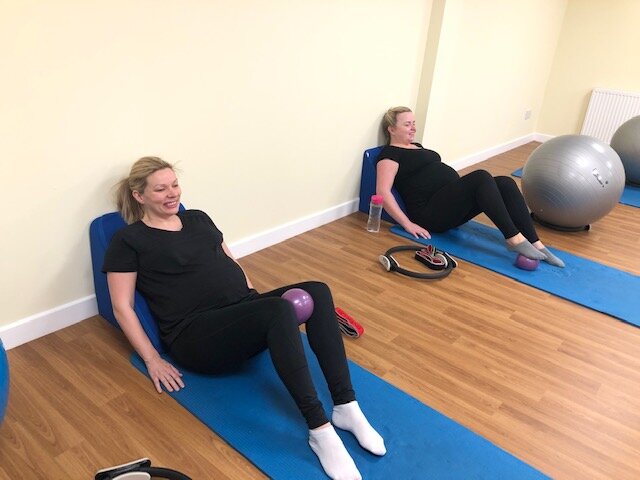
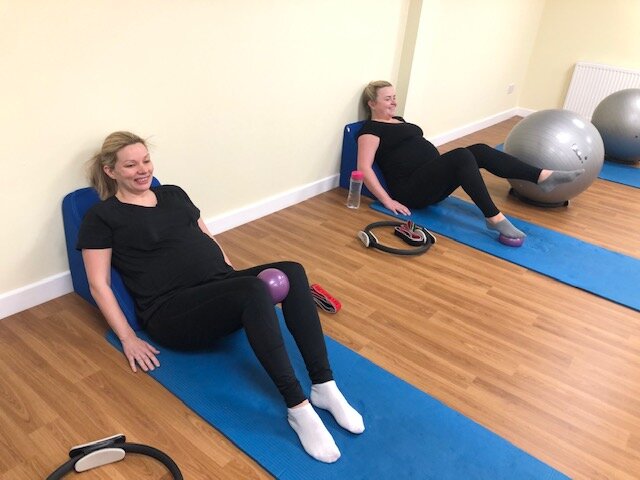
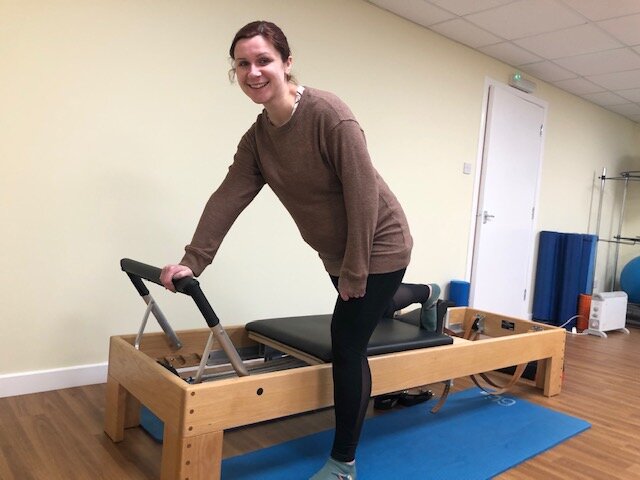
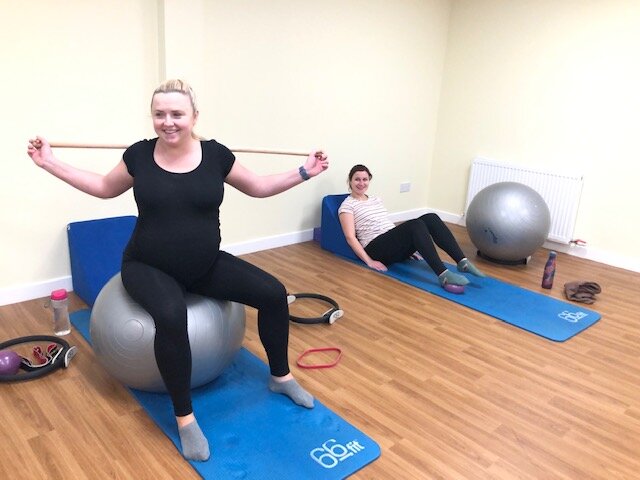
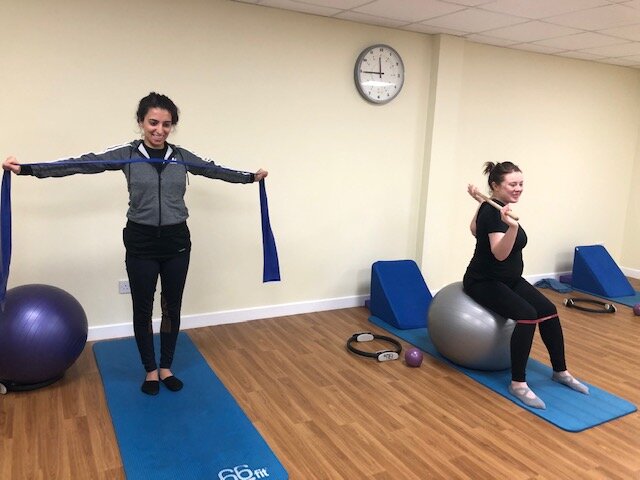
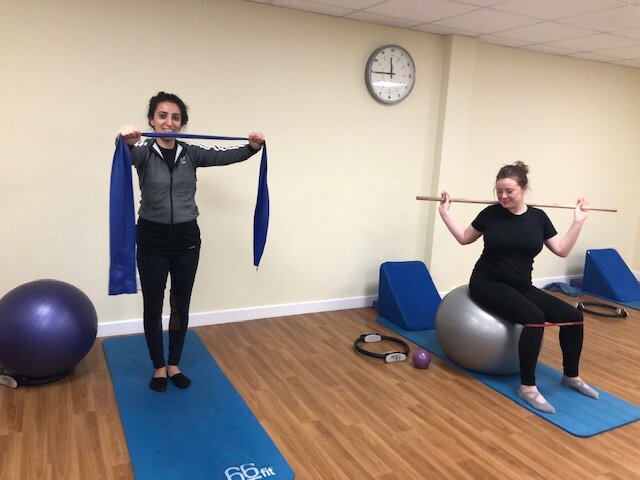
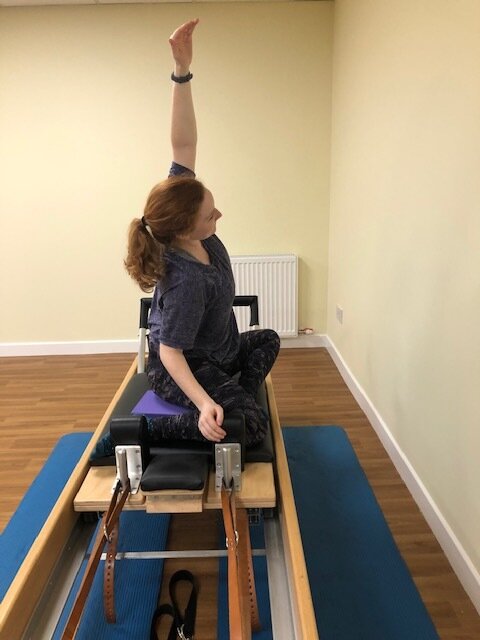
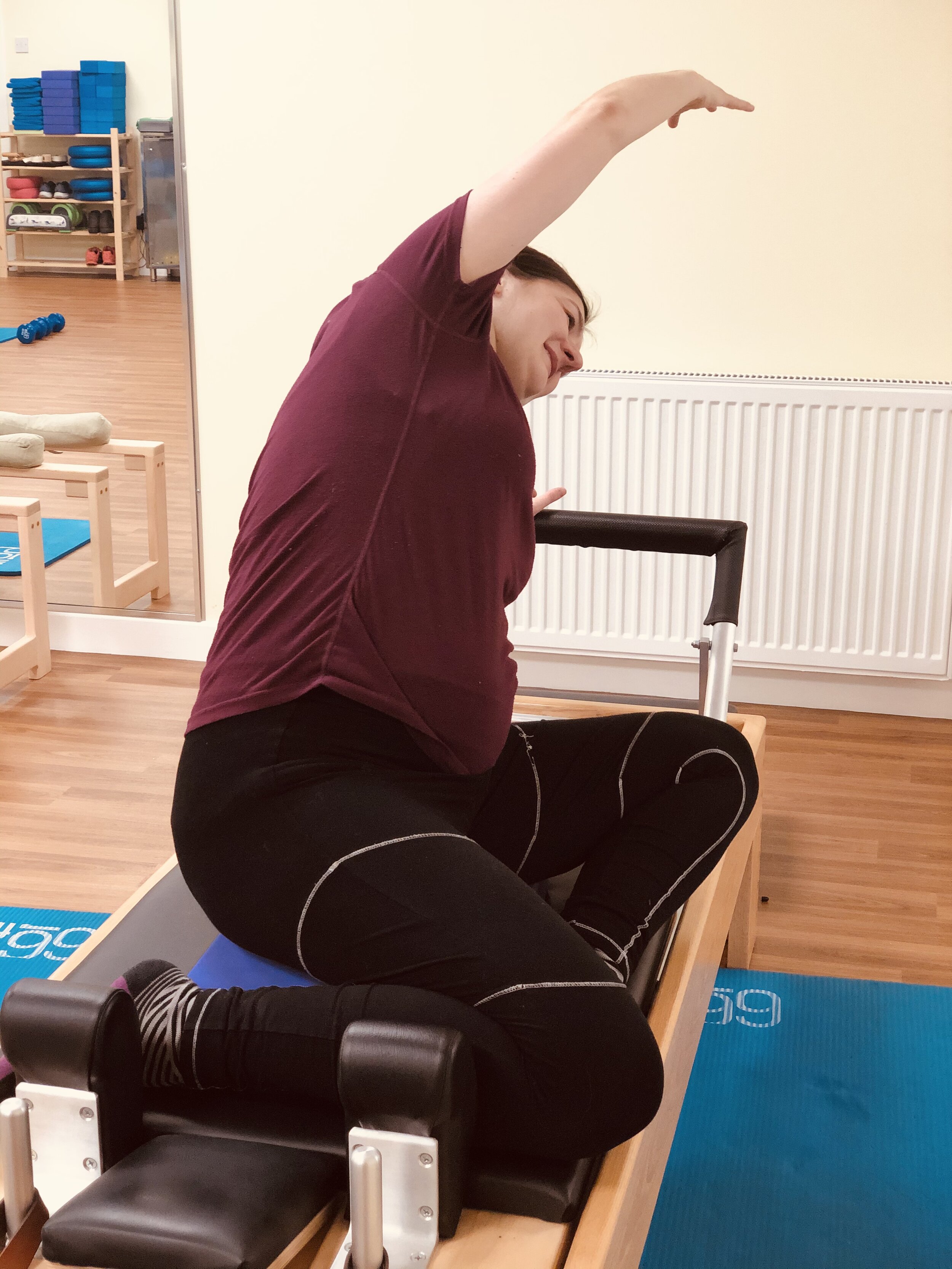
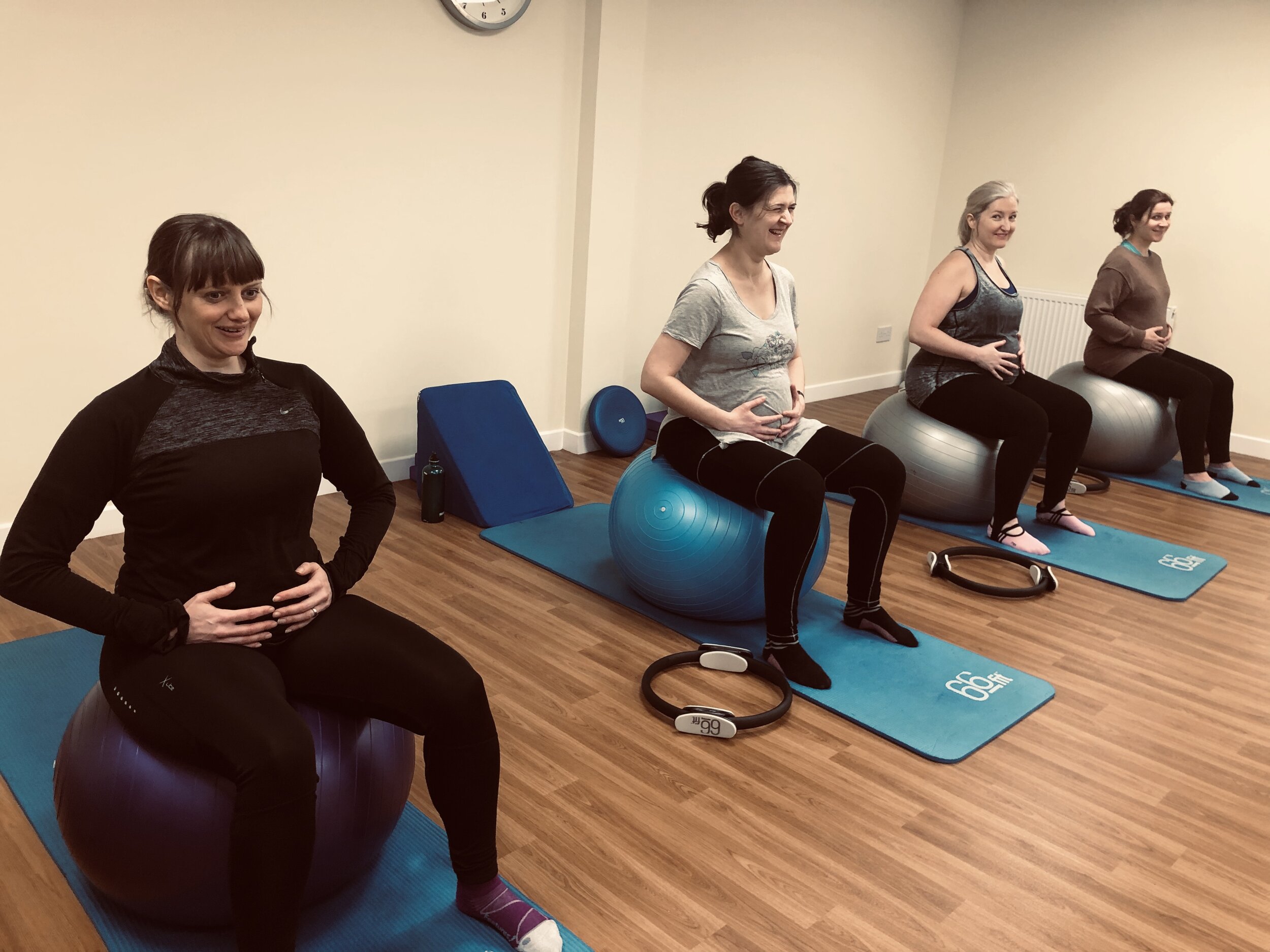
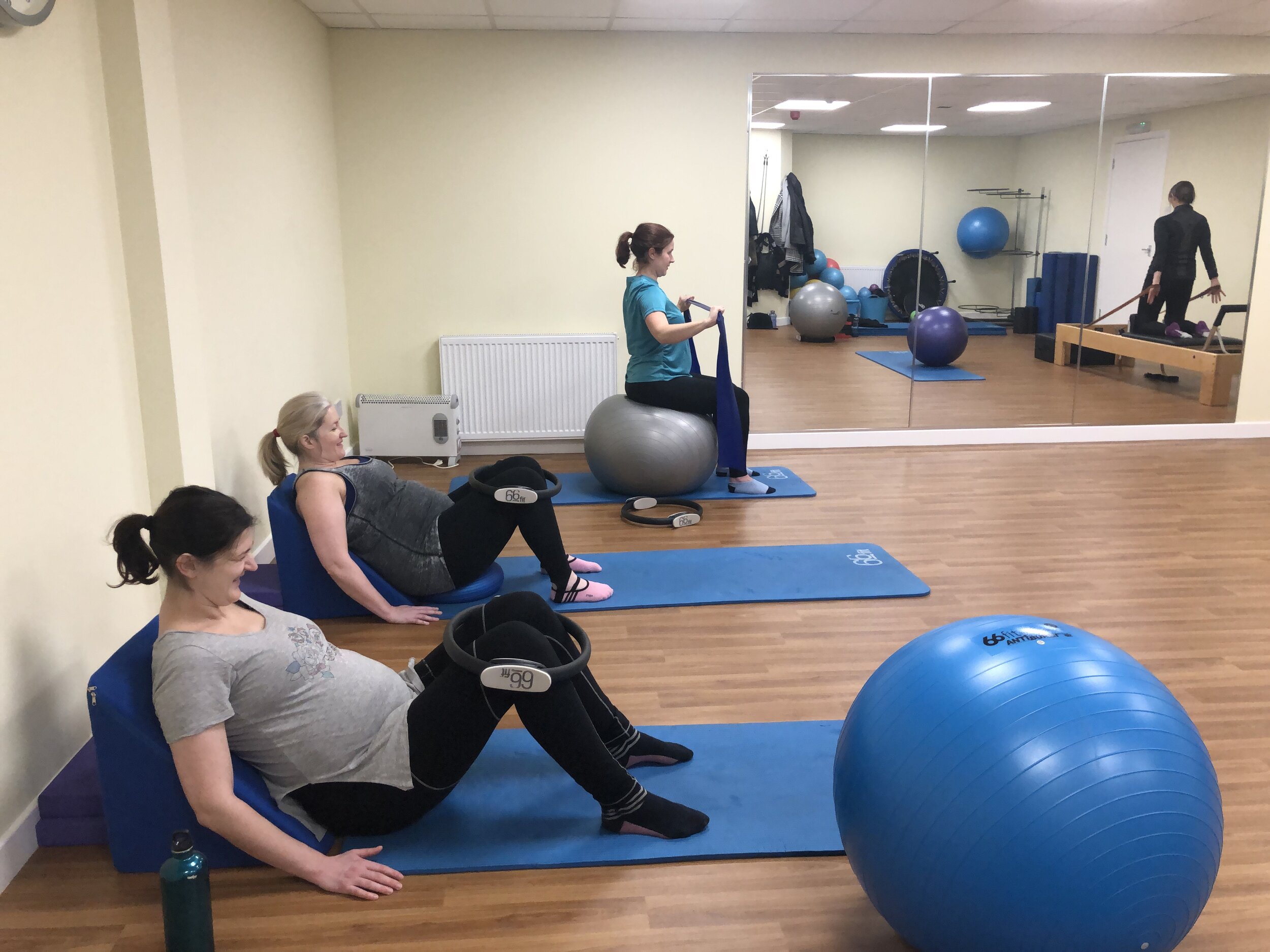
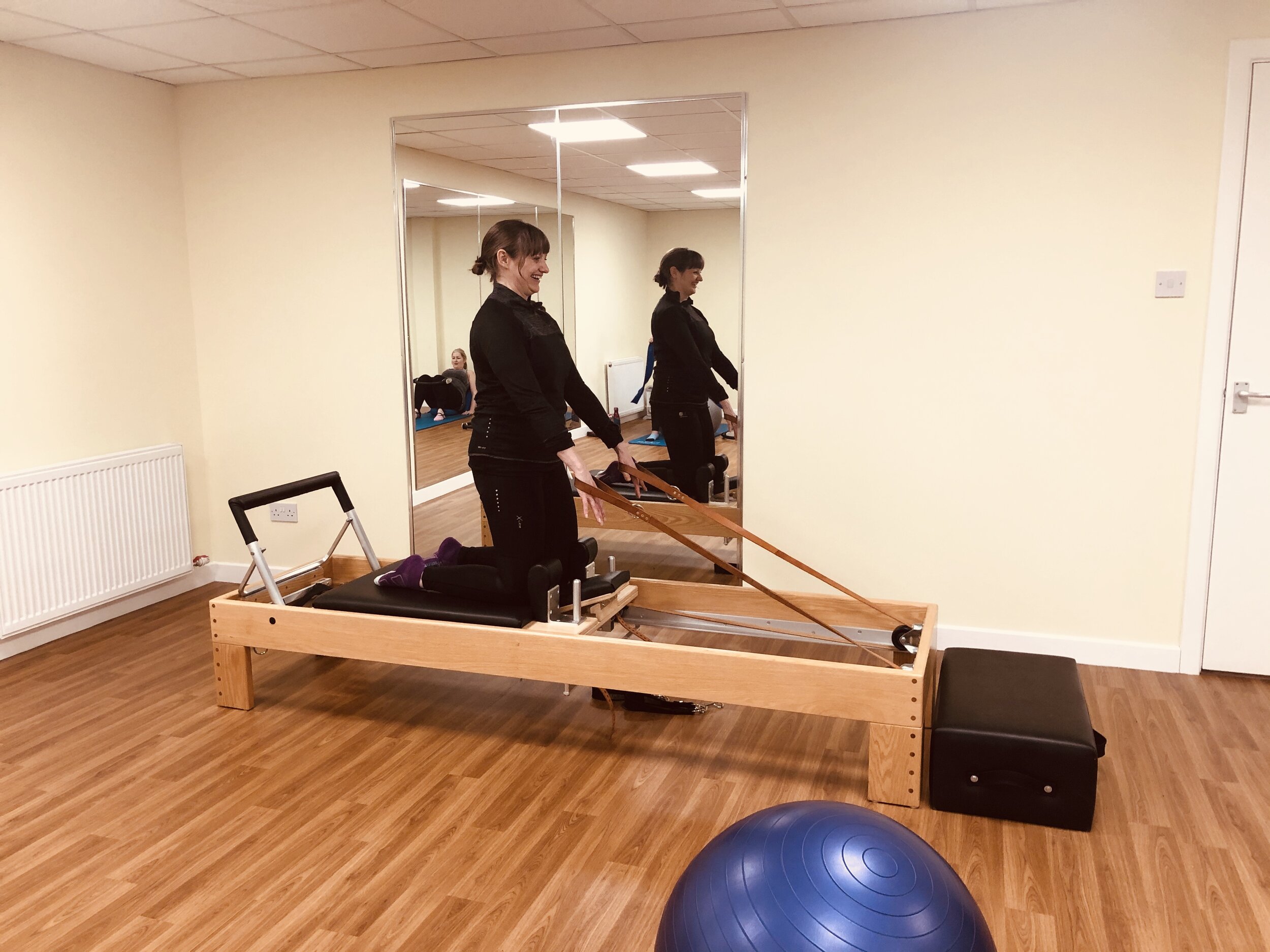
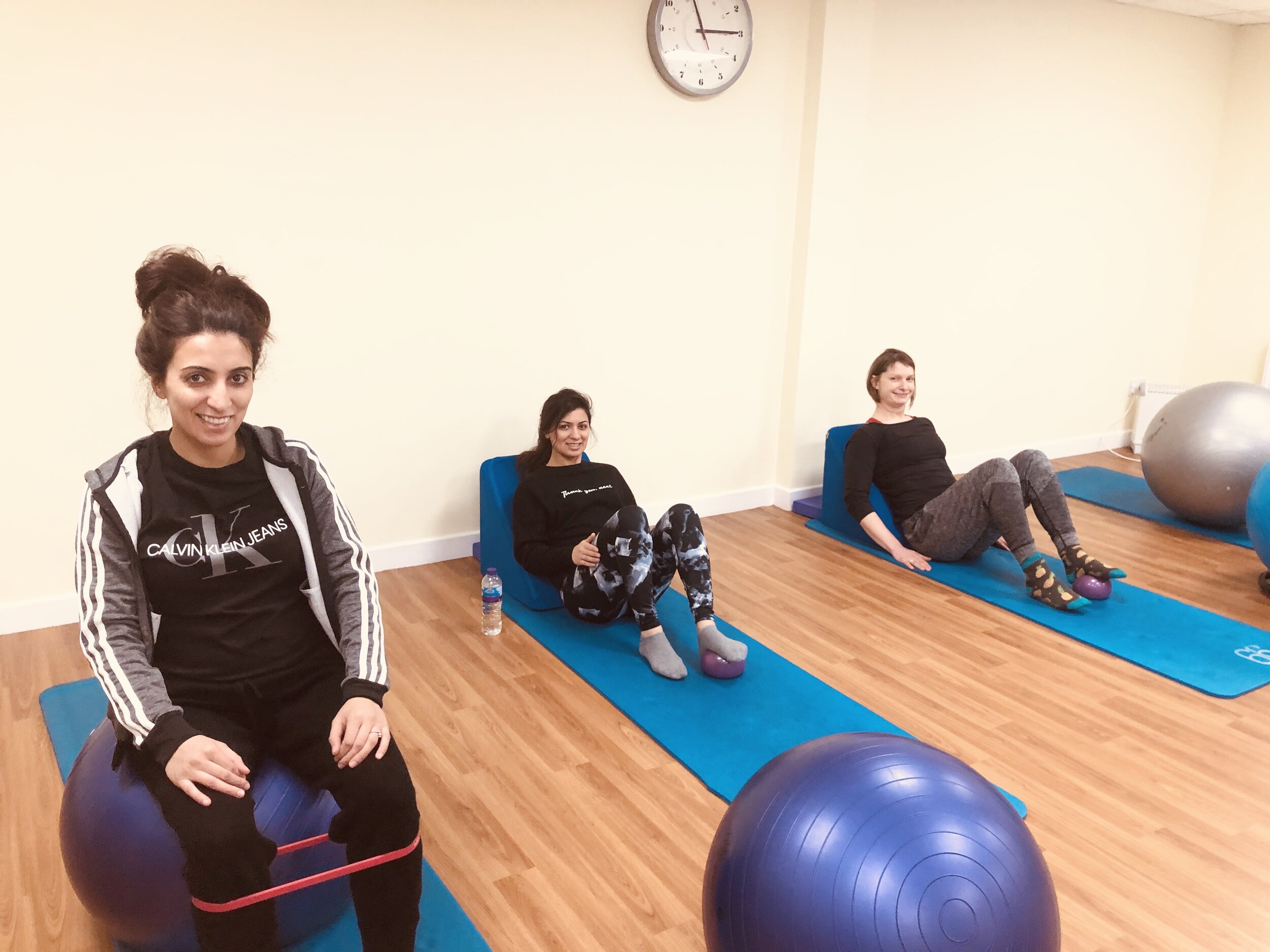
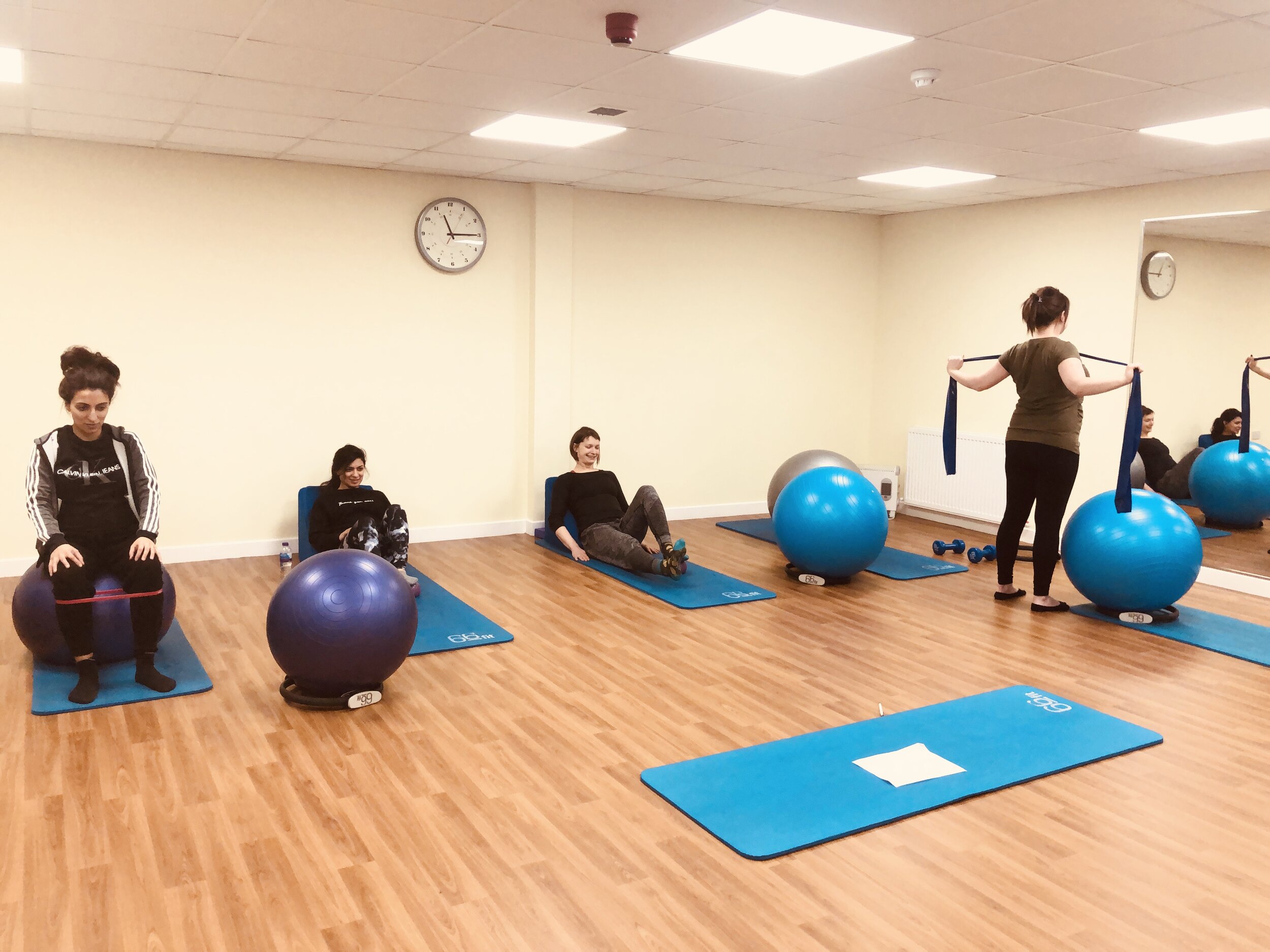
References;
Mottola MF, Davenport MH, Ruchat S, et al
2019 Canadian guideline for physical activity throughout pregnancy
British Journal of Sports Medicine 2018;52:1339-1346
Smith R, Reid H, Matthews A CMO Physical Activity Expert Committee for Physical Activity and Pregnancy, et al
Infographic: physical activity for pregnant women
British Journal of Sports Medicine 2018;52:532-533.
The report states that exercise during pregnancy has been shown to reduce high blood pressure and improve cardiovascular fitness. In addition, it can lower the risk of pregnancy related diabetes and gestational weight gain.
My favourite most recent ante natal exercise paper is “2019 Canadian guideline for physical activity throughout pregnancy”. A group of experts in the field have summarised their recommendations and highlighted the evidence they have to back these up as well as writing a detailed list of who should seek further advice before beginning an exercise program. See this link to read the paper in full.
Below is a summary of their main findings.
‘Strong recommendation’ and have ‘moderate’ quality evidence to support this. (The reason they have said the evidence is ‘moderate’ is because it can be challenging to get enough high quality studies that have enough people in them and are designed robustly to back up their statements.)
All women with normal pregnancies should be active throughout.
At least 150 minutes of moderate level physical activity should be accumulated to achieve these health benefits and reduce pregnancy complications
Accumulating this activity over a minimum of 3 days a week is recommended, however daily activity is encouraged.
Higher evidence and so can be seen as an agreed fact (This is a ‘strong recommendation’ with ‘high’ quality evidence, which is great news for exercising mums to be!):
The types of exercise recommended includes a variety of aerobic and resistance training. Stretching and yoga can also be beneficial.
Common practice however seen as ‘weak recommendations’ as have ‘low-quality’ evidence to back them up:
Women should be taught the correct technique for pelvic floor muscle exercises and carry these out daily to reduce the chance of continence issues.
Women who experience nausea, light-headedness or feel unwell when exercising flat on their back, should modify their exercises to avoid this position.
Antenatal Classes at Physio Effect
Our antenatal class offered at Physio Effect incorporates the above guidelines by contributing to the recommended exercise volume & frequency. Stretching, resistance and pelvic floor exercises are given under guidance by a trained physiotherapist. In addition, exercise position is modified with use of equipment such as a foam wedge and the Pilates reformer. It’s also a great way to meet other mums to be. Please click here for details on booking the class.
Note that we also offer a post-natal program which you can bring your baby along to. This is designed to help restore your body and gently bring to back to the correct level of exercise. Find out more about our CryBaby Pilates classes here.
Our antenatal Pilates class is a bespoke class, individually designed for each person who attends. Clients will be assessed by a physiotherapist who will design and teach the class. For example, the program can help with any musculoskeletal injuries and pregnancy related issues such as pelvic girdle pain. In addition, stage of pregnancy, pelvic floor exercises and safe positions for exercise will be incorporated into this programme.



